- Link to facebook
- Link to linkedin
- Link to twitter
- Link to youtube
- Writing Tips

What Does Proofreading Mean? Definition and Checklist
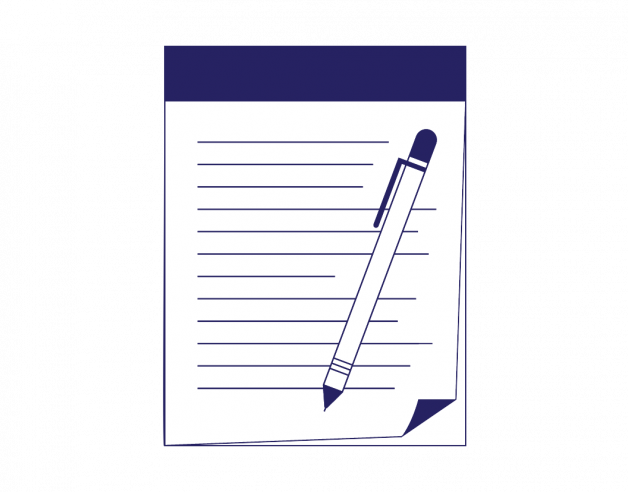
- 6-minute read
- 7th February 2023
Proofreading is an important step in the writing process that ensures high-quality, professional, error-free writing. In this article, you’ll learn all about proofreading, including effective techniques and tips and a checklist you can use at home.
What Is Proofreading?
Proofreading is the process of carefully reviewing written work to find and correct errors in grammar, punctuation, spelling, and formatting. It is the final step in the writing process; it ensures clean, clear, and professional writing before submission or publication. Keep in mind that proofreading differs from other writing steps, such as revising or editing , so be sure you know how the steps differ and when they should be completed in the writing process.
The Importance of Proofreading
Proofreading is important because it helps you catch mistakes you may have made during the writing stage. Proofreading ensures that your work is polished and professional and that your ideas are clear. Proofreading is especially important for writing that will be viewed by a larger audience or published: novels, short stories, online articles, etc. In formal writing, such as academic papers, business proposals, and resumes, proofreading is equally important because it shows professionalism and attention to detail from the writer.
How to Proofread
While proofreading can be as simple as reading over an email before hitting send . it can be more involved , depending on the type of document in question. Proofreading involves reading your work carefully, line by line, and looking for errors in grammar, punctuation, spelling, and formatting.
Tips for Effective Proofreading
Whether you are proofreading your own writing or that of others, here are some great tips to make sure you don’t miss a stray comma!
Leave Plenty of Time
Make sure you have plenty of time to proofread before your deadline, especially if you are proofreading your own writing. When you are proofreading your own writing, it can be particularly difficult to catch mistakes. If possible, wait a couple of days after you finish writing before you go back and proofread. This way, you will have fresh eyes and a new perspective.
Read Your Work
Reading your work in different ways will highlight mistakes that may be missed otherwise. Here are three ways you can read your work to catch mistakes and get a different perspective on your writing:
Read from the bottom to the top: Start with the last sentence and go all the way to the first. This helps isolate each sentence so you can focus on errors.
Read out loud: Read your work out loud in funny or strange voices. Pretend you are a robot or an opera singer to highlight grammar errors or awkward sentences that need your attention.
Use the read aloud function: Most word processing systems have a read aloud option. Listening to someone else (or a computer) read your work gives you the perspective of a listener or a different reader and further aids in the proofreading process.
Use a Proofreading Checklist
A checklist can alleviate some of the mental fatigue of trying to remember everything you need to look for in a text. You’ll find a great proofreading checklist below to use at home.
Take Breaks
You are not a super(wo)man or a machine. Take a ten-minute break every hour or so to give your eyes and mind a rest. When you become too familiar with a text, you will start to skim over mistakes and errors. Be sure to get movement in also during your breaks to avoid any physical stiffness or discomfort.
Get a Fresh Set of Eyes
Whether it’s a friend, a peer, or a professional proofreader , having someone else look for mistakes and give feedback is always helpful. They will have a different perspective and can offer fresh ideas to enhance your writing.
Proofreading Checklist
If you’re not sure what to look for while proofreading, here’s a checklist you can copy and paste for future use.
● Spelling: Check for misspelled and commonly confused words (e.g., there vs. their or affect vs. effect ).
● Grammar: Check for subject–verb agreement , verb tenses , and article use .
Find this useful?
Subscribe to our newsletter and get writing tips from our editors straight to your inbox.
● Punctuation: Check for proper use of periods , commas , semicolons , colons , apostrophes , and quotation marks .
● Capitalization : Check for capitalization of proper nouns, the first word of sentences, and specified words in titles and headings (nouns, verbs, adjectives, etc.).
● Formatting: Check for consistency in fonts, spacing, and alignment.
● Contractions ( I’m , can’t , should’ve , etc.): Do not use contractions in academic or business writing.
● Clarity: Check for wordiness, redundancy, and awkward phrasing.
● Accuracy: Check for any factual errors or inaccuracies.
● Citations and the reference list : Check for proper in-text citation and reference list formatting.
● Consistency: Check for consistency in language, tone, and style.
Or if you’re serious about proofreading properly, check out our official Proofed Proofreading Checklist . It’s what our expert proofreaders use!
Proofreading is an important step in the writing process because it helps to ensure that your work is clear, professional, and easy to understand. Be sure to set time aside to proofread your work, take frequent breaks during the process, and use a checklist so you don’t miss a mistake.
What are some common mistakes to look for when proofreading?
Check for spelling, punctuation, grammar, capitalization, and formatting mistakes. Make sure the writing is clear, concise, and consistent. Reword sentences that are wordy, overly lengthy, or awkward. Overall, you want to have error-free, polished, and professional text.
How can I improve my proofreading skills?
The best way to improve your proofreading skills is through practice and experience. Having a strong command of English grammar and writing mechanics is imperative. Consider taking a proofreading course, such as the one offered by Knowadays , to get expert feedback and materials if you are serious about becoming a proofreader.
What’s the difference between proofreading and editing?
Proofreading focuses on grammar, spelling, punctuation, and formatting mistakes. Think of it as the final polish in the writing process. Editing comes before proofreading in the writing process and focuses on the content, organization, and overall structure of the writing.
Where can I hire a professional to proofread my work for me?
Proofed has a team of more than 750 professional editors with expertise in fields across the board. We work with researchers, students, Fortune 500 companies, and independent authors to make their writing clean, professional, and ready for publication. Take advantage of our free trial today.
Share this article:
Post A New Comment
Got content that needs a quick turnaround? Let us polish your work. Explore our editorial business services.
3-minute read
What Is a Content Editor?
Are you interested in learning more about the role of a content editor and the...
4-minute read
The Benefits of Using an Online Proofreading Service
Proofreading is important to ensure your writing is clear and concise for your readers. Whether...
2-minute read
6 Online AI Presentation Maker Tools
Creating presentations can be time-consuming and frustrating. Trying to construct a visually appealing and informative...
What Is Market Research?
No matter your industry, conducting market research helps you keep up to date with shifting...
8 Press Release Distribution Services for Your Business
In a world where you need to stand out, press releases are key to being...
How to Get a Patent
In the United States, the US Patent and Trademarks Office issues patents. In the United...

Make sure your writing is the best it can be with our expert English proofreading and editing.

- Onsite training
3,000,000+ delegates
15,000+ clients
1,000+ locations
- KnowledgePass
- Log a ticket
01344203999 Available 24/7
What is Proofreading?: A Step-by-Step Guide
Master the art of flawless content with our blog “What is Proofreading? A Step-by-Step Guide. Dive into the intricacies of the Proofreading process and learn how to enhance the quality of your writing. Elevate your communication skills by understanding the nuances of Proofreading. Uncover the secrets to error-free content creation with our comprehensive blog.

Exclusive 40% OFF
Training Outcomes Within Your Budget!
We ensure quality, budget-alignment, and timely delivery by our expert instructors.
Share this Resource
- Creative Writing Course
- E-mail Etiquette Training
- Touch Typing Course
- Data Entry Masterclass
- Office Skills Training

Table of Contents
1) Understanding “What is Proofreading?” and its aspects
2) Importance of Proofreading
3) Benefits of Proofreading
4) Step-by-step guide to Proofreading
a) Review the content
b) Check for spelling and grammar errors
c) Verify consistency and style
d) Ensure proper formatting
e) Cross-check facts and references
f) Read aloud for clarity and flow
g) Proofread in multiple rounds
5) Conclusion
Understanding “ What is Proofreading ?” and its aspects
Before we move on to the step-by-step guide, we will first define Proofreading. Proofreading is the meticulous process of reviewing written content to identify and correct errors in grammar, spelling, punctuation, formatting, and overall clarity. Understanding Proofreading is essential for anyone involved in the writing process. Let's explore the key aspects of understanding Proofreading in more detail:
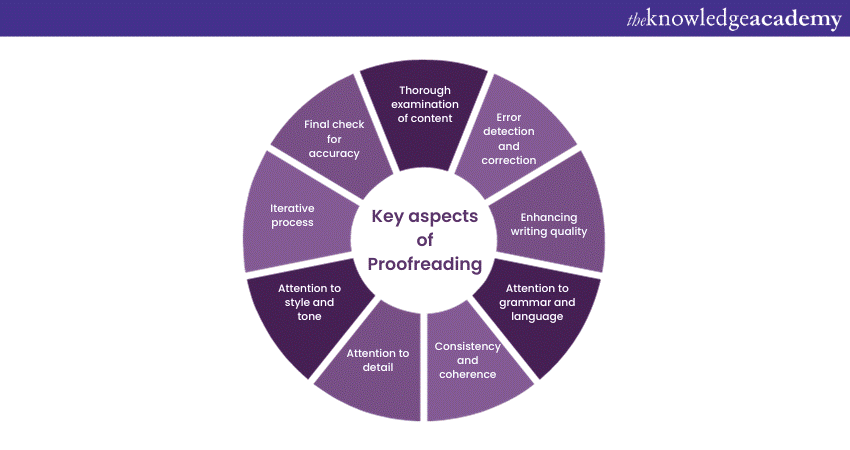
1) Thorough examination of content: Proofreading goes beyond a cursory read-through of a document. It involves a meticulous examination of the content to identify and rectify errors. This examination encompasses grammar, punctuation, spelling, formatting, consistency, style, and overall coherence.
2) Error detection and correction: The primary goal of Proofreading is to identify and correct errors in written materials. These errors can range from simple typos and grammatical mistakes to more complex issues like inconsistent formatting or unclear sentence structure. Proofreading ensures that these errors are identified and fixed, resulting in polished and error-free content.
3) Enhancing writing quality: Proofreading is an integral part of the writing process that contributes to improving the overall quality of the written work. By eliminating errors, Proofreading enhances the clarity, readability, and coherence of the content. It ensures that the message is effectively conveyed to the intended audience.
4) Attention to grammar and language: Proofreading involves paying close attention to grammar and language usage. It includes checking for proper subject-verb agreement, verb tenses, correct word choice, and sentence structure. Through Proofreading, inconsistencies and errors in grammar and language are identified and rectified, ensuring that the writing adheres to the rules and conventions of the English language.
5) Consistency and coherence: Proofreading also focuses on maintaining consistency and coherence throughout the document. This includes checking for consistent use of terminology, formatting, headings, and citation styles. By ensuring consistency, Proofreading helps to create a cohesive and unified piece of writing that is easier for readers to follow and understand.
6) Attention to detail: Proofreading requires a keen eye for detail. It involves scrutini s ing every aspect of the writing, including punctuation, spacing, indentation, and formatting. By paying attention to these details, Proofreading helps to eliminate errors and inconsistencies that might otherwise be overlooked.
7) Attention to style and tone: Proofreading considers the style and tone of the writing. It ensures that the content aligns with the desired style guide or guidelines. This includes checking for appropriate language usage, tone consistency, and adherence to specific writing conventions. Proofreading ensures that the writing maintains the intended style and tone, enhancing the overall effectiveness of the message.
8) Iterative process: Proofreading is an iterative process that involves multiple rounds of review. Each round focuses on different aspects, such as grammar, spelling, formatting, consistency, or style. Through these rounds, errors are gradually eliminated, and the content is refined for optimal quality.
9) Final check for accuracy: Proofreading serves as the final check for accuracy before the content is published or shared. It verifies the factual accuracy of information, confirms proper citations and references, and ensures the overall integrity of the content. By conducting this final accuracy check, Proofreading helps to maintain the credibility and reliability of the written work.
Elevate your P roofreading skills with our Proofreading Masterclass and unlock the power of error-free written communication!
Importance of Proofreading
Now that we know the definition of Proofreading and its aspects, let's delve into the key reasons W hy Proofreading is Important :
1) Maintaining credibility: Proofreading ensures that your written work is free from errors, showcasing your professionalism and attention to detail. By presenting polished and accurate content, you establish credibility and trust with your readers. Whether it's an academic paper, business document, or blog post, Proofreading demonstrates your commitment to delivering high-quality work.
2) Enhancing clarity and understanding: Clear and error-free writing is essential for effective communication. Proofreading helps eliminate grammar, spelling, and punctuation mistakes that can hinder comprehension. By ensuring your writing is clear and coherent, you help readers understand your ideas and messages accurately, avoiding any confusion or misinterpretation.
3) Polishing the presentation: Proper Proofreading ensures that your writing adheres to the desired formatting, style, and tone. Consistency in formatting, headings, font usage, and indentation contributes to a professional and polished appearance. When your work is well-presented and consistent, it reflects positively on your writing skills and attention to detail.
4) Quality assurance: Proofreading is a quality assurance step that helps you deliver the best possible work. It enables you to identify and rectify any weak points, inconsistencies, or areas for improvement in your writing. By striving for excellence through Proofreading, you demonstrate your commitment to producing high-quality content.
5) Professional growth: Engaging in the Proofreading process consistently can enhance your writing skills and attention to detail. It trains you to identify and correct errors, refine your style, and develop a stronger command of language. Over time, regular Proofreading helps you become a more proficient writer and communicator.

Benefits of Proofreading
Proofreading is considered to be an essential step in the writing process that offers numerous benefits. Let's explore the key benefits of Proofreading in more detail:
1) Enhanced credibility and professionalism: Proofreading ensures that your written content is free from errors, making it more credible and professional. When your work is polished and error-free, it demonstrates your attention to detail and dedication to producing high-quality materials. This, in turn, enhances your credibility and reputation as a writer or organi s ation .
2) Improved clarity and comprehension: Proofreading helps to clarify your ideas and improve the overall coherence of your writing. By eliminating errors, awkward phrasing, and unclear sentences, you make your content easier to understand for your audience. Clear and well-structured writing enhances comprehension, allowing your readers to grasp your message more effectively.
3) Minimi s ed m isinterpretation and confusion: Error-free writing reduces the risk of misinterpretation or confusion among your readers. When your content is clear and accurate , it ensures that your message is conveyed precisely as intended. This helps to avoid any misunderstandings and ensures that your readers correctly grasp the information or ideas you are trying to communicate.
4) Increased professionalism in communication: Whether you are writing an academic paper, a business report, or a blog post, Proofreading adds a professional touch to your communication. It shows that you take your work seriously and have a high standard of quality. Professionally proofread content reflects positively on your image and fosters trust and respect from your readers.
5) Improved readability and engagement: Proofreading enhances the readability of your content, making it more engaging for your audience. By eliminating errors, awkward sentences, and confusing phrases, you create a smooth and enjoyable reading experience. When your writing flows well and is free from distractions, readers are more likely to stay engaged and continue reading.
6) Maintained brand consistency: For businesses and organi s ations , Proofreading helps to maintain brand consistency across written materials. By adhering to consistent language, style, and tone, you reinforce your brand's identity and messaging. Consistent and error-free writing contributes to a cohesive and professional brand image.
7) Error-free facts and references: Proofreading ensures the accuracy of facts, data, quotes, and references in your content. Cross-checking and verifying information during the Proofreading process helps you to avoid spreading misinformation or using unreliable sources. Accurate and properly cited information strengthens the credibility of your work and builds trust with your readers.
8) Reduced embarrassment and reputational damage: Proofreading is a proactive measure to prevent embarrassing mistakes or errors that can damage your reputation. Typos, grammatical errors, or factual inaccuracies can undermine your professionalism and credibility. By thoroughly Proofreading your content, you minimi s e the risk of publishing content with avoidable mistakes.
9) Better writing habits and skills: Regularly engaging in the Proofreading process helps you develop better writing habits and skills. By paying attention to the details and identifying errors, you become more conscious of your writing style, grammar rules, and formatting conventions. Over time, this improves your overall writing proficiency and enables you to produce higher-quality content.
Master the art of Attention Management and reclaim control of your time with our transformative Attention Management Training !
Step-by-step guide to Proofreading
This section of the blog will present you with a step-by-step guide to Proofreading:
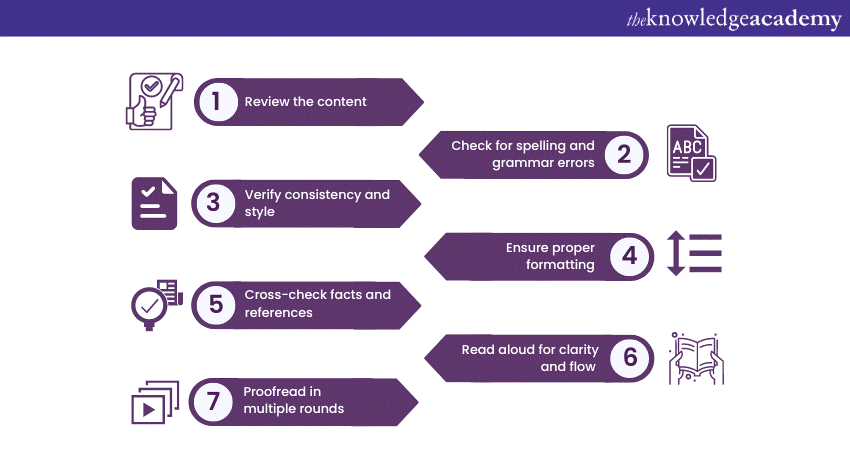
Review the c ontent
To begin the Proofreading process, start by reviewing the entire content. This step allows you to gain a comprehensive understanding of the material, its purpose, and the target audience. While reviewing, take note of any areas that require attention or improvements.
Check for s pelling and g rammar e rrors
Next, thoroughly check the content for spelling and grammar errors. Look out for common mistakes such as typos, misspelt words, incorrect verb forms, subject-verb agreement issues, and punctuation errors. Utili s e spelling and grammar check tools, but you must remember that they are not foolproof and should be used alongside manual review.
Verify c onsistency and s tyle
Consistency in writing is vital for maintaining a smooth flow and ensuring the readers' comprehension. Verify that the terminology, formatting, headings, and citation styles are consistent throughout the document. Also, adhere to the specified style guide or guidelines, such as the Oxford Style Manual or The Guardian Style Guide, to maintain a unified and professional appearance.
Ensure p roper f ormatting
Formatting plays a significant role in the overall presentation of the document. Pay attention to the font styles, sizes, line spacing, margins, and indentation. Ensure that the formatting is consistent throughout and adheres to the desired standards or guidelines. Well-formatted content enhances readability and gives a polished look to the document.
Cross-check f acts and r eferences
For content that relies on facts, data, or references, it is essential to cross-check their accuracy and reliability. Verify the information, statistics, quotes, and references against credible sources. Ensure that all facts are properly cited and attributed. This step helps maintain the credibility of the content and avoids spreading misinformation.
Read a loud for c larity and f low
Reading the content aloud is a valuable technique to assess its clarity, flow, and overall effectiveness. Pay attention to sentence structure, coherence between paragraphs, and the overall tone of the writing. Reading aloud helps identify awkward phrasing, unclear sentences, and areas that may require rephrasing or restructuring to enhance the reader's understanding and engagement.
Proofread in m ultiple r ounds
To ensure thorough Proofreading , it is recommended to go through multiple rounds of review. Each round can focus on specific aspects such as grammar, spelling, consistency, formatting, and style. Taking breaks between rounds allows you to approach the content with a fresh perspective, making it easier to spot any overlooked errors or areas for improvement.
During each round, carefully review the content, making necessary corrections and adjustments. Pay attention to the changes made in previous rounds to ensure consistency and accuracy throughout the document. This iterative process helps refine the content and ensure its quality.
Conclusion
Proofreading is a critical process in the journey of producing impeccable written content. By following the step-by-step guide outlined in this blog, you can improve the accuracy, clarity, and professionalism of your writing. Remember to dedicate ample time and attention to each stage of the Proofreading process to ensure optimal results. Hope this blog answered all your questions on What is Proofreading!
Ignite your personal development journey with our comprehensive Personal Development Training and unlock your true potential today!
Frequently Asked Questions
Upcoming business skills resources batches & dates.
Fri 7th Jun 2024
Fri 16th Aug 2024
Fri 4th Oct 2024
Fri 6th Dec 2024
Get A Quote
WHO WILL BE FUNDING THE COURSE?
My employer
By submitting your details you agree to be contacted in order to respond to your enquiry
- Business Analysis
- Lean Six Sigma Certification
Share this course
Our biggest spring sale.

We cannot process your enquiry without contacting you, please tick to confirm your consent to us for contacting you about your enquiry.
By submitting your details you agree to be contacted in order to respond to your enquiry.
We may not have the course you’re looking for. If you enquire or give us a call on 01344203999 and speak to our training experts, we may still be able to help with your training requirements.
Or select from our popular topics
- ITIL® Certification
- Scrum Certification
- Change Management Certification
- Business Analysis Courses
- Microsoft Azure Certification
- Microsoft Excel & Certification Course
- Microsoft Project
- Explore more courses
Press esc to close
Fill out your contact details below and our training experts will be in touch.
Fill out your contact details below
Thank you for your enquiry!
One of our training experts will be in touch shortly to go over your training requirements.
Back to Course Information
Fill out your contact details below so we can get in touch with you regarding your training requirements.
* WHO WILL BE FUNDING THE COURSE?
Preferred Contact Method
No preference
Back to course information
Fill out your training details below
Fill out your training details below so we have a better idea of what your training requirements are.
HOW MANY DELEGATES NEED TRAINING?
HOW DO YOU WANT THE COURSE DELIVERED?
Online Instructor-led
Online Self-paced
WHEN WOULD YOU LIKE TO TAKE THIS COURSE?
Next 2 - 4 months
WHAT IS YOUR REASON FOR ENQUIRING?
Looking for some information
Looking for a discount
I want to book but have questions
One of our training experts will be in touch shortly to go overy your training requirements.
Your privacy & cookies!
Like many websites we use cookies. We care about your data and experience, so to give you the best possible experience using our site, we store a very limited amount of your data. Continuing to use this site or clicking “Accept & close” means that you agree to our use of cookies. Learn more about our privacy policy and cookie policy cookie policy .
We use cookies that are essential for our site to work. Please visit our cookie policy for more information. To accept all cookies click 'Accept & close'.
What Is Proofreading? Everything You Need to Know about Having Your Work Proofread
#scribendiinc
Your boss or professor may have told you in the past that you need to proofread your work before submitting it. Although you didn't admit it at the time, it's possible that you asked yourself the following questions: What is proofreading anyway? What is involved in the proofreading process? Why should I even bother?
You might know that proofreading does not involve in-depth changes or fact checking and that proofreading is not the same as editing . It seems that, when we're talking about proofreading, the matter of what proofreading is not comes up a lot more than what proofreading is .
While that information is helpful, it still doesn't answer your original question: what is proofreading?
Here's the simplest definition, which the rest of this article will explain in greater detail:
Proofreading is the process of reviewing the final draft of a piece of writing to ensure consistency and accuracy in grammar, spelling, punctuation, and formatting.
What is traditional proofreading?
One of the things clouding people's understanding of what proofreading entails is the fact that the word is used differently in different fields. Asking "What is proofreading?" to someone in the publishing profession, for example, will likely garner a very different reply than asking someone at a university.
Someone in the publishing industry would view proofreading as the last possible opportunity to revise a manuscript before it is printed and published. The proofreader compares the proofs—printed versions of the manuscript, which include all the formatting, page numbers, headers, etc. that will be included in the final edition—with the edited copy to make sure that no errors have been introduced by the formatting or printing.
But wait—I thought proofreading was about fixing spelling mistakes?
The word proofreading has taken on a definition separate from the role it plays in the publication of manuscripts.
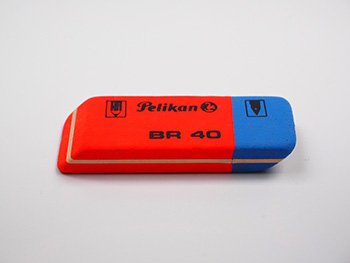
What most people are referring to when they use the word proofreading is the process of checking a document for any kind of grammatical, typographical, or formatting errors. Proofreading should always be the last step taken before a document is published online, handed in to a professor, submitted for a job application, or otherwise shared with its intended audience.
What kinds of errors are identified and fixed during proofreading?
By the time a document is ready to be proofread, it should have been edited already. This means its content should already be well organized, well written, and easy to understand. Editing also involves removing errors, but it focuses more on making sure the document makes sense as a whole.
Proofreading, on the other hand, is about finding errors both small and large that were either missed or introduced during editing. Proofreaders ensure that the document's final draft is completely free of grammatical errors (e.g., subject–verb agreement problems, incorrect word choices, improper punctuation usage, and incorrect spelling) as well as formatting and typographical errors. They also make sure the document adheres to the chosen style guide.
Unlike traditional proofreaders in the publishing industry, document proofreaders are not limited in the number of revisions they can make to a document, as there is generally no elevated proofreading cost associated with making more changes. However, if proofreaders find that most of the document still requires extensive changes, they may recommend that it undergo another round of editing.
Though a proofread is less extensive than an edit, it is an important step when preparing a piece of writing to be read by other people, as errors can cause confusion or be seen as unprofessional. Scribendi's proofreading services will help you polish your writing and ensure it is ready for your readers.
Image sources: Unsplash.com, Hans/Pixabay.com
Achieve Perfect Writing with High-Quality Proofreading
Try our personal proofreading service , or get a free sample.
Have You Read?
"The Complete Beginner's Guide to Academic Writing"
Related Posts
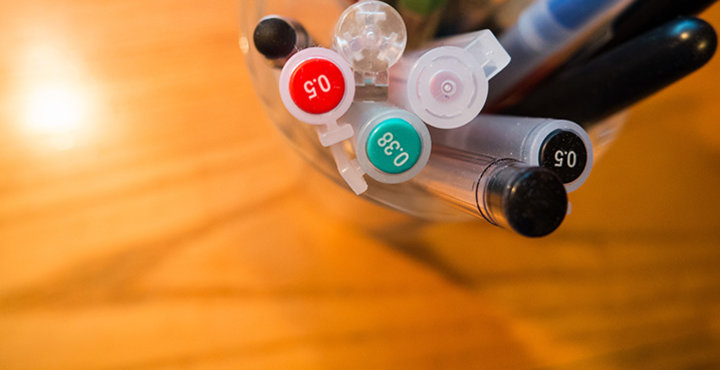
Copy Editing and Why You Need It

Editing Sites: 6 Ways to Determine Credibility Before You Buy

Value Proofreading: How Much Does Proofreading Cost in 2024?
Upload your file(s) so we can calculate your word count, or enter your word count manually.
We will also recommend a service based on the file(s) you upload.
English is not my first language. I need English editing and proofreading so that I sound like a native speaker.
I need to have my journal article, dissertation, or term paper edited and proofread, or I need help with an admissions essay or proposal.
I have a novel, manuscript, play, or ebook. I need editing, copy editing, proofreading, a critique of my work, or a query package.
I need editing and proofreading for my white papers, reports, manuals, press releases, marketing materials, and other business documents.
I need to have my essay, project, assignment, or term paper edited and proofread.
I want to sound professional and to get hired. I have a resume, letter, email, or personal document that I need to have edited and proofread.
Prices include your personal % discount.
Prices include % sales tax ( ).

- USC Libraries
- Research Guides
Organizing Your Social Sciences Research Paper
- 10. Proofreading Your Paper
- Purpose of Guide
- Design Flaws to Avoid
- Independent and Dependent Variables
- Glossary of Research Terms
- Reading Research Effectively
- Narrowing a Topic Idea
- Broadening a Topic Idea
- Extending the Timeliness of a Topic Idea
- Academic Writing Style
- Choosing a Title
- Making an Outline
- Paragraph Development
- Research Process Video Series
- Executive Summary
- The C.A.R.S. Model
- Background Information
- The Research Problem/Question
- Theoretical Framework
- Citation Tracking
- Content Alert Services
- Evaluating Sources
- Primary Sources
- Secondary Sources
- Tiertiary Sources
- Scholarly vs. Popular Publications
- Qualitative Methods
- Quantitative Methods
- Insiderness
- Using Non-Textual Elements
- Limitations of the Study
- Common Grammar Mistakes
- Writing Concisely
- Avoiding Plagiarism
- Footnotes or Endnotes?
- Further Readings
- Generative AI and Writing
- USC Libraries Tutorials and Other Guides
- Bibliography
Proofreading is the act of reviewing, identifying, and correcting errors in your research paper before it is handed in to be graded by your professor. Common errors found within the text of a paper can be both typographical [i.e., an error in typing] and grammatical [i.e., faulty, unconventional use of language]. However, the act of proofreading can also include identifying and correcting problems with the narrative flow of your paper [i.e., the logical sequence of thoughts and ideas], problems with concise writing [i.e., wordiness and imprecise vocabulary], and problems created by word processing software applications [e.g., unintentional font types, indented paragraphs, line spacing, uneven margins, or orphan headings, sentences, or words].
Editing and Proofreading Strategies. Writing@CSU. Colorado State University; Proofreading. The Writing Center. University of Wisconsin, Madison.
Proofreading Strategies
Proofreading is often the final act before handing in your paper. It is important because most professors grade papers not only on the quality of how you addressed the research problem and the overall organization of the study, but also on the quality of the grammar, punctuation, formatting, and narrative flow of your paper. The assigning of research papers is not just an exercise in developing good research and critical thinking skills, but it is also intended to help you become a better writer. Below are step-by-step strategies you can follow.
Before You Proofread
- Revise the larger aspects of the text . Don't proofread for the purpose of making corrections at the sentence and word level [the act of editing] if you still need to work on the overall focus, development, and organization of the paper or you need to re-arrange or change specific sections [the act of revising].
- Set your paper aside between writing and proofreading . Give yourself a day or so between the writing of your paper and proofreading it. This will help you identify mistakes more easily. This is also a reason why you shouldn't wait until the last minute to draft your paper because it won't provide the time needed to step away before proofreading.
- Eliminate unnecessary words before looking for mistakes . Throughout your paper, you should try to avoid using inflated diction if a more concise phrase works equally well. Simple, precise language is easier to proofread than overly complex sentence constructions and vocabulary. At the same time, also identify and change empty or repetitive phrases.
- Know what to look for . Make a mental note of the mistakes you need to watch for based on comments from your professor on previous drafts of the paper or that you have received about papers written in other classes. This will help you to identify repeated patterns of mistakes more readily.
- Review your list of references . Review the sources mentioned in your paper and make sure you have properly cited them in your bibliography. Also make sure that the titles cited in your bibliography are mentioned in the text. Any omissions should be resolved before you begin proofreading your paper.
NOTE: Do not confuse the act of revising your paper with the act of editing it. Editing is intended to tighten up language so that your paper is easier to read and understand. This should be the focus when you proofread. If your professor asks you to revise your paper, review the text above concerning ways to improve the overall quality of your paper. The act of revision implies that there is something within the paper that needs to be changed, improved, or re-organized in some significant way. If the reason for a revision is not specified, always ask for clarification.
Individualize the Act of Proofreading
Individualizing your proofreading process to match weaknesses in your writing will help you correct errors more efficiently and effectively . For example, I still tend to make subject-verb agreement errors. Accept the fact that you likely won't be able to check for everything, so be introspective about what your typical problem areas are and look for each type of error individually. Here's how:
- Think about what errors you typically make . Review instructors' comments about your writing and/or set up an appointment to review your paper with a staff member in the Writing Center .
- Learn how to fix those errors . Talk with your professor about helping you understand why you make the errors you do so that you can learn how to avoid them while writing.
- Use specific strategies . Develop strategies you are most comfortable with to find and correct your particular errors in usage, sentence structure, spelling, and punctuation.
- Where you proofread is important! Effective and efficient proofreading requires extended focus and concentration. If you are easily distracted by external activity or noise, proofread in a quiet corner of the library rather than at a table in Starbucks.
- Proofread in several short blocks of time . Avoid trying to proofread your entire paper all at once, otherwise, it will be difficult to maintain your concentration. A good strategy is to start your proofreading each time at the beginning of your paper. It will take longer to make corrections, but you may be surprised how many mistakes you find in text that you have already reviewed.
In general, verb tense should be in the following format, although variations can occur within the text of each section depending on the narrative style of your paper. Note that references to prior research mentioned anywhere in your paper should always be stated in the past tense.
- Abstract--past tense [summary description of what I did]
- Introduction--present tense [I am describing the study to you now]
- Literature Review--past tense [the studies I reviewed have already been published]
- Methodology--past tense [the way I gathered and synthesized data has already happened]
- Results--past tense [the findings of my study have already been discovered]
- Discussion--present tense [I am talking to you now about how I interpreted the findings]
- Conclusion--present tense [I am summarizing the study for you now]
General Strategies for Strengthening Your Paper
As noted above, proofreading involves a detailed examination of your paper to ensure there are no content errors. However, proofreading is also an opportunity to strengthen the overall quality of your paper beyond correcting specific grammar, diction, or formatting mistakes. Before you begin reviewing your paper line-by-line, step back and reflect on what you have written; consider if there are ways to improve each section of the paper by taking into consideration the following “big picture” elements of good writing.
Introduction . Look for any language that reflects broad generalizations, indeterminate phrasing, or text that does not directly inform the reader about the research and its significance. This can include unnecessary qualifiers or text, such as, "This study includes a significant review of the literature [what constitutes "significant"?], "There are a number of findings that are important [just state the number of findings; leave it to the discussion to argue the context of their importance], and, for example, "This research reminds me of...." [why does the research study relate to remembering something; is this first person perspective essential to introducing the research problem].
Research Topic . Make sure the topic does not come across as ambiguous, simplistic, overly broad, or ill-defined. A strong research problem and the associated research questions establish a set of assumptions that should be nuanced, yet challenges the reader to think. Review the Choosing a Research Problem page in this guide. Place yourself in the position of a reader totally unfamiliar with the topic, then, critically evaluate the research problem, any associated research questions you are trying to address, and the theoretical framework. Ask yourself if there is anything that may not make sense or requires further explanation or refinement. The rest of the paper will build on these elements, but the introduction of these foundational aspects of your paper should be clearly and concisely stated.
Paragraph Transitions . Review the overall paper to make sure the narrative flow is coherent throughout and that there are smooth transitions between paragraphs. Ensure that major transitions in text have a heading or sub-heading [if needed] and that the paragraph prior to the transition let's the reader know that you are about to shift to a new idea. Also, look for text that is overly long or that contains too much description and too little analysis and interpretation. Sometimes you need a long paragraph to describe a complex idea, event, or issue, but review them to make sure they can't be broken apart into shorter, more readable paragraphs.
Discussion of Results . Read over your discussion of the research findings and make sure you have not treated any of the evidence as unproblematic or uncomplicated. Make sure you have discussed the results through a critical lens of analysis that takes into account alternative interpretations or possible counter-arguments. In most cases, your discussion section should demonstrate a thorough understanding of the study's findings and their implications, both positive, supportive findings and negative, unanticipated findings.
Conclusion . Make sure you have done more than simply re-state the research problem and what you did. Provide the reader with a sense of closure by ensuring that the conclusion has highlighted all the main points of the paper and tells the reader why the study was important, what the paper's broader significance and implications might be, and, if applicable, what areas of the study require further research. Also note that the conclusion is usually no more than two or three paragraphs. If your conclusion is longer, look for ways to condense the text and be alert to information that is superfluous or should be integrated into other parts of your paper [e.g., new information].
Specific Strategies to Help Identify Errors
Once you have made any necessary revisions to your paper and looked for ways to strengthen its overall quality, focus on identifying and correcting specific errors within the text.
- Work from a printout, not a computer screen . Besides sparing your eyes from the strain of glaring at a computer screen, proofreading from a printout allows you to easily skip around to where errors might have been repeated throughout the paper [e.g., misspelling the name of a person].
- Read out loud . This is especially helpful for spotting run-on sentences and missing words, but you'll also hear other problems that you may not have identified while reading the text out loud. This will also help you adopt the role of the reader, thereby helping you to understand the paper as your audience might.
- Use a ruler or blank sheet of paper to cover up the lines below the one you're reading . This technique keeps you from skipping over possible mistakes and allows you to deliberately pace yourself as you read through your paper.
- Circle or highlight every punctuation mark in your paper . This forces you to pay attention to each mark you used and to confirm its purpose in each sentence or paragraph. This is a particularly helpful strategy if you tend to misuse or overuse a punctuation mark, such as a comma or semi-colon.
- Use the search function of the computer to find mistakes . Using the Ctrl F search [find] feature can help identify repeated errors faster. For example, if you overuse a phrase or repeatedly rely on the same qualifier [e.g., "important"], you can do a search for those words or phrases and in each instance make a decision about whether to remove it, rewrite the sentence, or use a synonym.
- If you tend to make many mistakes, check separately for each kind of error , moving from the most to the least important, and following whatever technique works best for you to identify that kind of mistake. For instance, read through once [backwards, sentence by sentence] to check for fragments; read through again [forward] to be sure subjects and verbs agree, and again [perhaps using a computer search for "this," "it," and "they"] to trace pronouns to antecedents.
- End with using a computer spell checker or reading backwards word by word . Remember that a spell checker won't catch mistakes with homonyms [e.g., "they're," "their," "there"] or certain word-to-word typos [like typing "he" when you meant to write "the"]. The spell-checker function can catch some errors quickly, but it is not a substitute for carefully reviewing the text. This also applies to the grammar check function as well.
- Leave yourself enough time . Since many errors are made and overlooked by speeding through writing and proofreading, setting aside the time to carefully review your writing will help you identify errors you might otherwise miss. Always read through your writing slowly. If you read through the paper at a normal speed, you won't give your eyes sufficient time to spot errors.
- Ask a friend to read your paper . Offer to proofread a friend's paper if they will review yours. Having another set of eyes look over your writing will often spot errors that you would have otherwise missed.
NOTE: Pay particular attention to the spelling of proper nouns [an individual person, place, or organization]. Make sure the name is carefully capitalized and spelled correctly, and that this spelling has been used consistently throughout the text of your paper. This is especially true for proper nouns transliterated into English or that have been spelled differently over time. In this case, choose the spelling most consistently used by researchers in the literature you have cited so, if asked, you can explain the logic of your choice.
Carduner, Jessie. "Teaching Proofreading Skills as a Means of Reducing Composition Errors." Language Learning Journal 35 (2007): 283-295; Gaste, Barbara. “Editing and Proofreading Your Own Work.” American Medical Writers Association (AMWA) Journal 30 (2015): 147-151; Editing and Proofreading. Writing Center, University of North Carolina; Proofreading. Writing Center, University of Wisconsin, Madison; Proofreading. Writing Center, University of Maryland; Harris, Jeanette. "Proofreading: A Reading/Writing Skill." College Composition and Communication 38 (1987): 464-466; Editing and Proofreading. The Writing Center. University of North Carolina; Mintz, Steve. “Simple Ways to Strengthen Your Students’ Writing.” Higher Ed Gamma (Opinion). Inside Higher Ed , August 17, 2022; Revising vs. Proofreading, Kathleen Jones Wright Writing Center, Indiana University of Pennsylvania; Editing and Proofreading Strategies. Student Writing Support, University of Minnesota; Saleh, Naveed. The Writer's Guide to Self-Editing: Essential Tips for Online and Print Publication . Jefferson, NC: McFarland, 2019; Writing a Paper. Walden Writing Center, Walden University; The Writing Process: Proofreading. The Purdue Online Writing Lab, Purdue University.
USC Writing Center
S hould you need help proofreading your paper, take advantage of the assistance offered by consultants at the USC Writing Center located on the second floor of Taper Hall, room 216. Consultations are free and they can help you with any aspect of the writing process. Walk-in help is provided when consultants are available, but you should schedule an appointment online because the Center gets very busy as the semester progresses. If you meet with a consultant be sure to bring a copy of your writing assignment, any relevant handouts or texts, and any outlines or drafts you've written. Also, the Center conducts helpful, fifty minute small-group writing skills workshops for students that cover a wide range of topics. These workshops provide an opportunity for you to improve your skills related to an aspect of writing that you may be struggling with, particularly if English is not your native language.
- << Previous: Appendices
- Next: Common Grammar Mistakes >>
- Last Updated: Apr 5, 2024 1:38 PM
- URL: https://libguides.usc.edu/writingguide
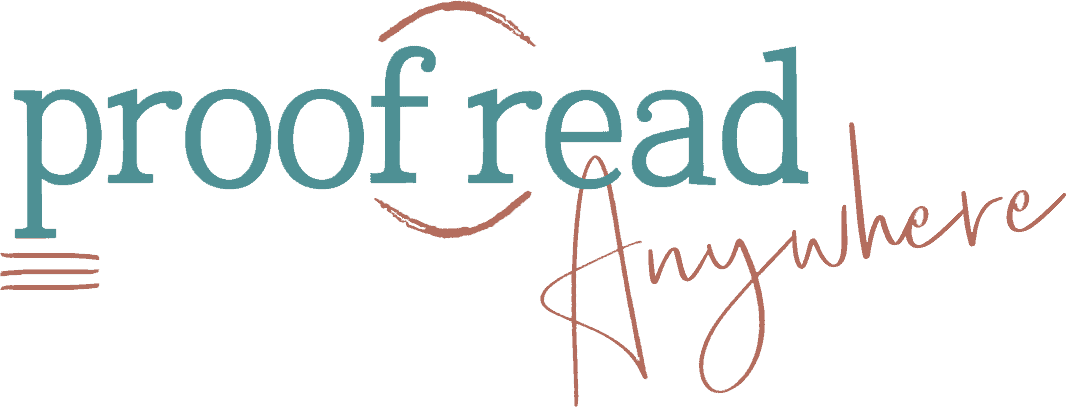
- Proofreading Courses
- Side Hustle Blog
- eBooks for Freelancers
- More Freelancer Resources
- Join Free Workshop
What is Proofreading and How to Become a Proofreader with No Experience
Do you know what I’ve just realized? I’ve been running a proofreading blog for six years and I’ve never done a basic “What is proofreading?” blog post!
Whoops! I assumed that everyone landing on my blog would already know what is involved in proofreading, so I wouldn’t need to go into it, but when I look at some of the frequently asked questions I receive, it’s obvious I haven’t been answering those questions on my blog.
So now I’m going right back to basics by taking an in-depth look at what proofreading is, who it’s a good fit for, and how you can become a proofreader.
If you’ve just hit on the idea of becoming a freelance proofreader, but you’re not really sure what it involves, keep reading!
What is proofreading and what kind of errors do proofreaders look for?
Proofreading is the last step in the editorial process. It comes after the document has already been through the developmental and copyediting stages. A proofreader’s eyes will be the final set of eyes to check the document before it is printed or published online.
A proofreader is responsible for double-checking documents for errors and typos, including:
- Double words (“the the,” “and and,” etc.)
- Punctuation
- Formatting issues
- Ensure document adheres to chosen style guide
Traditionally, proofreading would have been done when the book had been formatted and laid out, so proofreaders needed to focus on issues like awkward page and word breaks and inconsistencies in the layout.
The proofreader would compare the printed version of the manuscript (proofs) against the edited copy to ensure that no errors were introduced by the formatting process. That will still be the case if you work with publishing houses. Although the comparison may be done electronically now, rather than on printed proofs.
Nowadays, many proofreaders work with bloggers or directly with self-publishing authors, so the work is often carried out in Microsoft Word or Google Docs before the formatting stage.
The use of proofreading marks is becoming less common, but they’re still interesting to know about.
Why is proofreading important?

Proofreading ensures that your readers can immerse themselves in your content rather than get distracted by errors. If a document is full of typos or grammatical errors, the reader will be yanked right out of the story. They will be trying to understand what the writer meant rather than enjoying what they read or learning from it.
Proofreaders also protect a writer’s or business’s reputation. We stop them from making embarrassing or costly mistakes.
In the online era, it’s even more important to make sure as few errors slip through the cracks as possible as if they don’t, the writer can get torn apart on social media. Internet trolls take no prisoners!
What’s the difference between editing and proofreading?
A lot of people get mixed up between proofreading and copyediting or assume that they’re the same thing.
They are similar, but there are some key differences.
Both copyeditors and proofreaders check for errors in grammar, spelling, and punctuation; however, copyeditors make changes at a sentence or word level. They suggest alternative words or rewrite sentences. A proofreader doesn’t rewrite.
It’s important to identify the correct level of editing required. Otherwise, you may end up copyediting at a proofreading rate.
I covered the differences between proofreading and copyediting in detail in this post.
Who hires proofreaders? Are proofreaders in demand?
A lot of people wonder if proofreaders are in demand. The answer to that is YES!
The great thing about being a proofreader is that there are many markets where you can find work. None of these markets are oversaturated with quality proofreaders.
Here are some of the proofreading clients you can work with:
- Self-publishing authors
- Publishing houses
- College or graduate students
- Anyone with a résumé/LinkedIn profile
- Web content creators
- Marketing managers
- Graphic designers
- Script writers
- Transcriptionists
- Business owners/entrepreneurs
- Court reporters
With so many different potential clients available, it can be difficult to narrow down your marketing message. Choosing a proofreading niche is a great way to tailor your marketing to a select group of people so they can find you more easily.
When choosing a niche, consider what your interests and experience are like.
Do you have a science degree? Maybe you could proofread academic papers in this area.
Have a hobby? Mention it on your website, so people who have written content about that topic are aware of your interest in the area.
Interested in the legal system? You could specialize in proofreading court transcripts. This is an even more specialized niche, and it’s one of my favorites because it has greater scope for you to get repeat clients.
You can learn about the difference between general proofreading and transcript proofreading here.
Picking a niche allows you to position yourself as an expert, and you can build a reputation as an excellent proofreader for this particular topic.
What kind of documents need to be proofread?
Every single person or business that creates content needs a proofreader. As a result, the list of documents a proofreader could work on is almost endless.
Here are just some of the documents you could be hired to proofread:
- Essays/papers/theses
- White papers
- Résumés/LinkedIn profiles
- Newspaper articles
- Marketing copy
- General transcripts
- Legal transcripts
- Press releases
- Product descriptions
Haven’t proofreaders been replaced by apps like Word’s Spell Check and Grammarly now?
Nope! Proofreading tools like Grammarly or Word’s Spell Check can be a useful final check to make sure there are no remaining errors, but they shouldn’t be relied on as the only means of proofreading a document.
Tools like these often can’t pick up on context, so they may highlight things that are not errors. They may also be programmed to highlight errors that are really just myths or rules that have since changed.
As a result, the human mind is still better when it comes to proofreading!
What skills does a proofreader need?
Proofreaders need to have an above-average understanding of grammar, spelling, and punctuation rules. You can hone your grammar skills , but it’s better if you have a natural ability in this area and a tendency to spot errors.
You also need to have an eagle eye for detail. A person who skims while they read or who doesn’t care about the nitty-gritty will probably not be a good fit for proofreading.
If you routinely spot errors when reading books, blog posts, ads, billboards, menus, or just about any copy, there’s a good chance proofreading would be a good fit for you!
You must also possess soft skills like communication, time management, and the ability to meet deadlines. These are transferable skills that many people will have likely picked up in their previous work experience.
What qualifications do you need to be a proofreader?
You don’t require a degree to become a proofreader. All you need is an eagle eye for detail and strong knowledge of grammar, spelling, and punctuation rules.
Occasionally, if you want to proofread academic papers, you may be required to have a qualification in that area, but in general, you do not need a degree.
If you don’t have a degree or any proofreading experience, you can still get proofreading jobs from individuals like self-publishing authors or bloggers. In my experience — and the experience of many of my students — these kinds of clients are not concerned whether you have a degree or tons of experience.
That’s not to say you don’t need any proofreading training!
Even if you were top of your high school English class, chances are you will have forgotten a lot of the rules over the years. And you may never have been trained to follow a certain style guide so that you apply the rules consistently.
There’s still a lot to learn when it comes to working as a professional proofreader, but luckily it can be learned for much, much less than the cost of a degree.
Not only will proofreading training give you the confidence to do your job well but it will also ensure that you can compete with other proofreaders out there who have completed training.
How to become a proofreader
Now that you know what proofreading is, what it involves, and what skills you need, you may be wondering how to become a proofreader.
It all boils down to a few steps:
Hone your proofreading skills
If you want to become a successful proofreader, you must hone your editorial skills.
Proofreaders must have an eye for detail, above-average knowledge of grammar rules, and a willingness to research what they don’t know.
Even if you have a strong natural grammar ability, you still need to make sure that your knowledge of the rules is up to date as language changes over time. Continuous professional development is essential.
Taking a course is a great way to update your knowledge. My Proofread Anywhere courses not only test your grammar skills but they also teach you how to create a successful proofreading business.
I highly recommend taking a proofreading course before looking for clients, especially if you have no experience. My Transcript Proofreading course includes over 3,000 pages of practice transcripts, and my General Proofreading course includes 40 practice essays. That’s like having 40 practice clients before you even start!
Use your resources
Wondering what tools you need to become a proofreader?
The answer is very few. It really doesn’t cost much to start a proofreading business.
All you need is a laptop, a reliable internet connection, and a few grammar books or style guides .
To me, this is the most important part; you must use your resources if you want to be an excellent proofreader.
Style guides are manuals that provide guidelines for the grammar, punctuation, and formatting rules of various documents. Excellent proofreaders take the time to become very familiar with these guides.
Which style guides you will use depends on your niche and the types of documents you work with. The most used style guides are:
- The Chicago Manual of Style (CMOS)
- The Associated Press Stylebook (AP)
- The MLA Style Manual
- Publication Manual of the American Psychological Association (APA style)
My General Proofreading course is based on the Chicago Manual of Style guidelines.
Following a style manual will ensure that the document is consistent throughout, which will make it easier to read.
One of the best ways to get more familiar with grammar is to read grammar books. (They’re fun, I swear!)
Everyone makes mistakes — even proofreaders. Shocking, I know! Proofreaders are held to such a high standard, but sometimes we make mistakes. What can I say — this proofreader is still human!
But those mistakes get fewer and fewer the more we learn, so to get over your fear of making mistakes, get as much proofreading practice as you can.
Do online quizzes and look up any of the questions you get wrong.
Practice makes progress, y’all!
The more you practice proofreading, the more the errors will start to jump out at you. Many proofreaders comment on the fact that they now struggle to read for pleasure because they’re always subconsciously looking for errors.
That’s one tiny drawback, but the benefits of proofreading professionally more than make up for it like doing work you enjoy, the ability to make money from home, and the satisfaction of being your own boss.
I hope I’ve answered any questions you had about what proofreading is and how you can become a proofreader. If you have any other questions, please leave a comment below!
Ready to jump into being a freelance proofreader now that your questions have been answered? Check out our free proofreading course to learn how you can get started.
Leave a Reply
Your email address will not be published. Required fields are marked
Hi and thank you for all the great info. I am hesitant to start for a few reasons. One is that I have never considered myself a detail person, even though I constantly spot errors in writing. In other areas of my life I feel like I am more a big picture person, but maybe I am mistaken in that. Another thing is that I am VERY inept at computer stuff, since I have kept up on things, so Word has given me fits!! I attempted a proofreading online class and failed miserably because I couldn’t figure out how to use the program. What do you recommend? Should I take a class in Word? I keep coming back to proofreading as a way to earn some income, but these things are really holding me back.
Hi, Jonelle! Having a basic computer knowledge is a plus when beginning the program. There may just be more of a learning curve for you than others with more extensive knowledge, but the course teaches many different proofreading methods. Everything you need to know can be learned in the course. 🙂
This blog does a great job of summarizing what a proofreader is. I am preparing to take your course. I have pre-trained a little by reading a grammar book and glancing over the CMOS. Thank you for putting this together.
That’s great, Adam! Wishing you much success on your journey. 🙂
Hi Caitlin,
I spotted a spelling error in the article, What is Proofreading and How to Become a Proofreader with No Experience
In the article, where it list the different types of documents that can be proofread. Third line down, where it says 'essays/papers/theses'. The word 'theses' is spelt incorrectly. The correct spelling is 'thesis'.
****************************************************************************************** Here are just some of the documents you could be hired to proofread:
Books Blogs –>Essays/papers/theses<–
Hi, Rosemary! “Theses” is the plural form of “thesis.”
I have a fashion blog that shares tips and advice with my readers, and since I write the articles myself, I was thinking of hiring online proofreading services to help me double-check the articles before I upload them. It's a good thing you highlighted that proofreaders need to have a natural tendency to spot errors and an above-average understanding of grammar, spelling, and punctuation rules. I'll take note of this while I look for proofreaders to hire for my articles soon.
Write to us at [email protected] and we’ll send you our graduate directory so you can find a trained proofreader!
This Blog has given me a positive outlook. I just have to put in more effort and enjoy the process. Thank you.
Posts You Might Like
Meet the proofreading posse: brooke interview, proofreading certification, what are the best proofreading courses.

Editing and Proofreading
What this handout is about.
This handout provides some tips and strategies for revising your writing. To give you a chance to practice proofreading, we have left seven errors (three spelling errors, two punctuation errors, and two grammatical errors) in the text of this handout. See if you can spot them!
Is editing the same thing as proofreading?
Not exactly. Although many people use the terms interchangeably, editing and proofreading are two different stages of the revision process. Both demand close and careful reading, but they focus on different aspects of the writing and employ different techniques.
Some tips that apply to both editing and proofreading
- Get some distance from the text! It’s hard to edit or proofread a paper that you’ve just finished writing—it’s still to familiar, and you tend to skip over a lot of errors. Put the paper aside for a few hours, days, or weeks. Go for a run. Take a trip to the beach. Clear your head of what you’ve written so you can take a fresh look at the paper and see what is really on the page. Better yet, give the paper to a friend—you can’t get much more distance than that. Someone who is reading the paper for the first time, comes to it with completely fresh eyes.
- Decide which medium lets you proofread most carefully. Some people like to work right at the computer, while others like to sit back with a printed copy that they can mark up as they read.
- Try changing the look of your document. Altering the size, spacing, color, or style of the text may trick your brain into thinking it’s seeing an unfamiliar document, and that can help you get a different perspective on what you’ve written.
- Find a quiet place to work. Don’t try to do your proofreading in front of the TV or while you’re chugging away on the treadmill. Find a place where you can concentrate and avoid distractions.
- If possible, do your editing and proofreading in several short blocks of time. Your concentration may start to wane if you try to proofread the entire text at one time.
- If you’re short on time, you may wish to prioritize. Make sure that you complete the most important editing and proofreading tasks.
Editing is what you begin doing as soon as you finish your first draft. You reread your draft to see, for example, whether the paper is well-organized, the transitions between paragraphs are smooth, and your evidence really backs up your argument. You can edit on several levels:
Have you done everything the assignment requires? Are the claims you make accurate? If it is required to do so, does your paper make an argument? Is the argument complete? Are all of your claims consistent? Have you supported each point with adequate evidence? Is all of the information in your paper relevant to the assignment and/or your overall writing goal? (For additional tips, see our handouts on understanding assignments and developing an argument .)
Overall structure
Does your paper have an appropriate introduction and conclusion? Is your thesis clearly stated in your introduction? Is it clear how each paragraph in the body of your paper is related to your thesis? Are the paragraphs arranged in a logical sequence? Have you made clear transitions between paragraphs? One way to check the structure of your paper is to make a reverse outline of the paper after you have written the first draft. (See our handouts on introductions , conclusions , thesis statements , and transitions .)
Structure within paragraphs
Does each paragraph have a clear topic sentence? Does each paragraph stick to one main idea? Are there any extraneous or missing sentences in any of your paragraphs? (See our handout on paragraph development .)
Have you defined any important terms that might be unclear to your reader? Is the meaning of each sentence clear? (One way to answer this question is to read your paper one sentence at a time, starting at the end and working backwards so that you will not unconsciously fill in content from previous sentences.) Is it clear what each pronoun (he, she, it, they, which, who, this, etc.) refers to? Have you chosen the proper words to express your ideas? Avoid using words you find in the thesaurus that aren’t part of your normal vocabulary; you may misuse them.
Have you used an appropriate tone (formal, informal, persuasive, etc.)? Is your use of gendered language (masculine and feminine pronouns like “he” or “she,” words like “fireman” that contain “man,” and words that some people incorrectly assume apply to only one gender—for example, some people assume “nurse” must refer to a woman) appropriate? Have you varied the length and structure of your sentences? Do you tends to use the passive voice too often? Does your writing contain a lot of unnecessary phrases like “there is,” “there are,” “due to the fact that,” etc.? Do you repeat a strong word (for example, a vivid main verb) unnecessarily? (For tips, see our handouts on style and gender-inclusive language .)
Have you appropriately cited quotes, paraphrases, and ideas you got from sources? Are your citations in the correct format? (See the UNC Libraries citation tutorial for more information.)
As you edit at all of these levels, you will usually make significant revisions to the content and wording of your paper. Keep an eye out for patterns of error; knowing what kinds of problems you tend to have will be helpful, especially if you are editing a large document like a thesis or dissertation. Once you have identified a pattern, you can develop techniques for spotting and correcting future instances of that pattern. For example, if you notice that you often discuss several distinct topics in each paragraph, you can go through your paper and underline the key words in each paragraph, then break the paragraphs up so that each one focuses on just one main idea.
Proofreading
Proofreading is the final stage of the editing process, focusing on surface errors such as misspellings and mistakes in grammar and punctuation. You should proofread only after you have finished all of your other editing revisions.
Why proofread? It’s the content that really matters, right?
Content is important. But like it or not, the way a paper looks affects the way others judge it. When you’ve worked hard to develop and present your ideas, you don’t want careless errors distracting your reader from what you have to say. It’s worth paying attention to the details that help you to make a good impression.
Most people devote only a few minutes to proofreading, hoping to catch any glaring errors that jump out from the page. But a quick and cursory reading, especially after you’ve been working long and hard on a paper, usually misses a lot. It’s better to work with a definite plan that helps you to search systematically for specific kinds of errors.
Sure, this takes a little extra time, but it pays off in the end. If you know that you have an effective way to catch errors when the paper is almost finished, you can worry less about editing while you are writing your first drafts. This makes the entire writing proccess more efficient.
Try to keep the editing and proofreading processes separate. When you are editing an early draft, you don’t want to be bothered with thinking about punctuation, grammar, and spelling. If your worrying about the spelling of a word or the placement of a comma, you’re not focusing on the more important task of developing and connecting ideas.
The proofreading process
You probably already use some of the strategies discussed below. Experiment with different tactics until you find a system that works well for you. The important thing is to make the process systematic and focused so that you catch as many errors as possible in the least amount of time.
- Don’t rely entirely on spelling checkers. These can be useful tools but they are far from foolproof. Spell checkers have a limited dictionary, so some words that show up as misspelled may really just not be in their memory. In addition, spell checkers will not catch misspellings that form another valid word. For example, if you type “your” instead of “you’re,” “to” instead of “too,” or “there” instead of “their,” the spell checker won’t catch the error.
- Grammar checkers can be even more problematic. These programs work with a limited number of rules, so they can’t identify every error and often make mistakes. They also fail to give thorough explanations to help you understand why a sentence should be revised. You may want to use a grammar checker to help you identify potential run-on sentences or too-frequent use of the passive voice, but you need to be able to evaluate the feedback it provides.
- Proofread for only one kind of error at a time. If you try to identify and revise too many things at once, you risk losing focus, and your proofreading will be less effective. It’s easier to catch grammar errors if you aren’t checking punctuation and spelling at the same time. In addition, some of the techniques that work well for spotting one kind of mistake won’t catch others.
- Read slow, and read every word. Try reading out loud , which forces you to say each word and also lets you hear how the words sound together. When you read silently or too quickly, you may skip over errors or make unconscious corrections.
- Separate the text into individual sentences. This is another technique to help you to read every sentence carefully. Simply press the return key after every period so that every line begins a new sentence. Then read each sentence separately, looking for grammar, punctuation, or spelling errors. If you’re working with a printed copy, try using an opaque object like a ruler or a piece of paper to isolate the line you’re working on.
- Circle every punctuation mark. This forces you to look at each one. As you circle, ask yourself if the punctuation is correct.
- Read the paper backwards. This technique is helpful for checking spelling. Start with the last word on the last page and work your way back to the beginning, reading each word separately. Because content, punctuation, and grammar won’t make any sense, your focus will be entirely on the spelling of each word. You can also read backwards sentence by sentence to check grammar; this will help you avoid becoming distracted by content issues.
- Proofreading is a learning process. You’re not just looking for errors that you recognize; you’re also learning to recognize and correct new errors. This is where handbooks and dictionaries come in. Keep the ones you find helpful close at hand as you proofread.
- Ignorance may be bliss, but it won’t make you a better proofreader. You’ll often find things that don’t seem quite right to you, but you may not be quite sure what’s wrong either. A word looks like it might be misspelled, but the spell checker didn’t catch it. You think you need a comma between two words, but you’re not sure why. Should you use “that” instead of “which”? If you’re not sure about something, look it up.
- The proofreading process becomes more efficient as you develop and practice a systematic strategy. You’ll learn to identify the specific areas of your own writing that need careful attention, and knowing that you have a sound method for finding errors will help you to focus more on developing your ideas while you are drafting the paper.
Think you’ve got it?
Then give it a try, if you haven’t already! This handout contains seven errors our proofreader should have caught: three spelling errors, two punctuation errors, and two grammatical errors. Try to find them, and then check a version of this page with the errors marked in red to see if you’re a proofreading star.
Works consulted
We consulted these works while writing this handout. This is not a comprehensive list of resources on the handout’s topic, and we encourage you to do your own research to find additional publications. Please do not use this list as a model for the format of your own reference list, as it may not match the citation style you are using. For guidance on formatting citations, please see the UNC Libraries citation tutorial . We revise these tips periodically and welcome feedback.
Especially for non-native speakers of English:
Ascher, Allen. 2006. Think About Editing: An ESL Guide for the Harbrace Handbooks . Boston: Wadsworth Cengage Learning.
Lane, Janet, and Ellen Lange. 2012. Writing Clearly: Grammar for Editing , 3rd ed. Boston: Heinle.

For everyone:
Einsohn, Amy. 2011. The Copyeditor’s Handbook: A Guide for Book Publishing and Corporate Communications , 3rd ed. Berkeley: University of California Press.
Lanham, Richard A. 2006. Revising Prose , 5th ed. New York: Pearson Longman.
Tarshis, Barry. 1998. How to Be Your Own Best Editor: The Toolkit for Everyone Who Writes . New York: Three Rivers Press.
You may reproduce it for non-commercial use if you use the entire handout and attribute the source: The Writing Center, University of North Carolina at Chapel Hill
Make a Gift
Purdue Online Writing Lab Purdue OWL® College of Liberal Arts
Where Do I Begin?

Welcome to the Purdue OWL
This page is brought to you by the OWL at Purdue University. When printing this page, you must include the entire legal notice.
Copyright ©1995-2018 by The Writing Lab & The OWL at Purdue and Purdue University. All rights reserved. This material may not be published, reproduced, broadcast, rewritten, or redistributed without permission. Use of this site constitutes acceptance of our terms and conditions of fair use.
Proofreading is primarily about searching your writing for errors, both grammatical and typographical, before submitting your paper for an audience (a teacher, a publisher, etc.). Use this resource to help you find and fix common errors.
Proofreading can be a difficult process, especially when you’re not sure where to start or what this process entails. Think of proofreading as a process of looking for any inconsistencies and grammatical errors as well as style and spelling issues. Below are a few general strategies that can help you get started.
General Strategies Before You Proofread
General strategies while you proofread, when you are done.
- Make sure that you leave plenty of time after you have finished your paper to walk away for a day or two, a week, or even 20 minutes. This will allow you to approach proofreading with fresh eyes.
- Print out a hard copy. Reading from a computer screen is not the most effective way to proofread. Having a hardcopy of your paper and a pen will help you.
- Have a list of what to look for. This will help you manage your time and not feel overwhelmed by proofreading. You can get this list from previous assignments where your instructor(s) noted common errors you make.
- Don’t rush . Many mistakes in writing occur because we rush. Read slowly and carefully to give your eyes enough time to spot errors.
- Read aloud to yourself. Reading a paper aloud encourages you to read each word and can help you notice small mistakes.
- Read aloud to a friend and have the friend give you oral feedback.
- Have a friend read your paper aloud while you don’t read along.
- Use the search in document function of the computer to look for common errors from your list.
- Read from the end. Read individual sentences one at a time starting from the end of the paper rather than the beginning. This forces you to pay attention to the sentence itself rather than to the ideas of the paper as a whole.
- Role-play. While reading, put yourself in your audience's shoes. Playing the role of the reader encourages you to see the paper as your audience might.
- Have a friend look at your paper after you have made all the corrections you identified. A new reader will be able to help you catch mistakes that you might have overlooked.
- Make an appointment with a Writing Lab tutor if you have any further questions or want someone to teach you more about proofreading.
- Ask your teacher to look at the areas you usually have trouble with to see if you have made any progress.
Have a language expert improve your writing
Run a free plagiarism check in 10 minutes, automatically generate references for free.
- Knowledge Base
Quick Guide to Proofreading | What, Why and How to Proofread
Published on 19 September 2022 by Shona McCombes . Revised on 15 May 2023.
Proofreading means carefully checking for errors in a text before it is published or shared. It is the very last stage of the writing process , when you fix minor spelling and punctuation mistakes, typos, formatting issues and inconsistencies.
Proofreading is essential for any text that will be shared with an audience, whether it’s an academic paper, a job application, an online article, or a print flyer. Depending on your skills and budget, you can choose to proofread the text yourself or to hire a professional.
Instantly correct all language mistakes in your text
Be assured that you'll submit flawless writing. Upload your document to correct all your mistakes.

Table of contents
Proofreading example, proofreading vs editing, proofreading tips and tricks, choosing a proofreading service, recommended proofreading service, frequently asked questions about proofreading.
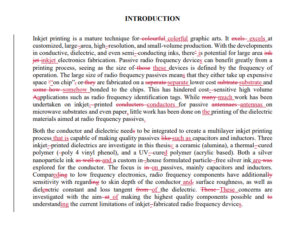
The only proofreading tool specialized in correcting academic writing
The academic proofreading tool has been trained on 1000s of academic texts and by native English editors. Making it the most accurate and reliable proofreading tool for students.

Correct my document today
Editing and proofreading are different steps in the process of revising a text. Editing can involve major changes to content, structure and language, but proofreading focuses only on minor errors and inconsistencies.
Often a text will go through several stages of editing before it is proofread. The table below shows some common steps in the editing process.
The four stages of editing and proofreading
Do i need to go through every stage.
It depends on the type and length of text. You don’t need to strictly follow the division of tasks shown above, but a good piece of writing will nearly always go through a similar process of revising, editing and proofreading.
In the traditional publishing process, the stages are clearly divided, with different professionals responsible for each revision. A separate proofread of the final print version is necessary, especially because new typographical errors can be introduced during production.
However, in texts that don’t need to be formatted for mass printing, there is often more overlap between the steps. Some editorial services combine copy editing and proofreading into a single stage (sometimes called proof-editing), where grammar, syntax and style are addressed at the same time as minor spelling and punctuation errors.
Basic proofreading skills are important for anyone who writes. For everyday texts, such as business reports, blogs, or college papers, there are some techniques you can use to proofread efficiently and effectively before sharing your work.
Edit your writing first
Before you get to the final stage of proofreading, make sure you’ve thoroughly revised and edited your work. There’s no point spending time fixing minor errors if you might later remove whole sections or rewrite paragraphs. Only proofread once you’ve got a completed final draft that you’re happy with.
Take a break from the text
When you’ve been reading and rereading the same words for hours or days, it becomes much harder to notice mistakes. Before proofreading, set your work aside for a while so that you can look at it with fresh eyes.
Ideally you should wait at least a day or two before final proofreading, but if you’re on a tight deadline, even a half hour break can help.
Proofread a printout
Seeing your words on a printed page is another useful strategy for noticing things that might have escaped your attention on the screen. If the final version will be printed, this is also a good chance to check your formatting is correct and consistent on the page.
Use digital shortcuts
While reading from print can help you spot errors, word processing software can help you fix them efficiently. Most obviously, run a spell check – but don’t rely on the computer to catch every mistake.
If you notice that you’ve repeatedly misspelled a particular word, inconsistently capitalised a term, or switched between UK and US English , you can use the Find and Replace function to fix the same mistake throughout the document.
Be careful, though, and don’t use ‘replace all’. Click through and check every replacement to avoid accidentally adding more errors!
Learn from your mistakes
Pay attention to the errors that keep recurring in the text. This can help you avoid them in future.
Knowing what to look out for is the most challenging part of proofreading. You’ll probably notice obvious typos, but subtle mistakes in grammar and punctuation can be harder to recognise. The table below shows some of the most common errors to look out for.
What to watch out for when proofreading
If you lack confidence in your written English, or if you just want to ensure you haven’t missed anything in an important document, you might want to consider using a professional proofreading service.
There are two main options: you can hire a freelance proofreader, or you can send your document to a proofreading and editing company. There are various things to consider when choosing a service.
Do you only need proofreading or also editing?
It’s important to have a clear idea of how much work your text requires. People often think they only need proofreading when, in reality, the text would benefit from some level of editing as well.
If you send a proofreader a document full of grammar mistakes, confusing sentences, and difficult-to-follow paragraphs, they might decline the job or recommend a different service.
Many freelancers and companies offer both editing and proofreading, either separately (with separate pricing) or combined into one service. Make sure you understand exactly what kind of changes are included. Will the editor only correct minor errors, or will they also comment on awkward phrasings and structural issues?
Should the proofreader be specialised in your type of document?
Many different types of documents require proofreading: from literary novels to technical reports, from PhD dissertations to promotional flyers. The best choice of service is usually one that’s specialised in your type of document.
While proofreaders and copy editors generally don’t need expert knowledge of the text’s content, the process will be smoother if your proofreader is familiar with the rules and conventions of the genre you’re working in.
How much does proofreading cost?
The cost of proofreading varies widely. The price depends partly on the proofreader’s location and level of experience, the type and length of text, and the turnaround time. Rates are usually calculated per word or per hour. If the service also focuses on formatting, it may be priced per page.
How long does proofreading take?
You should try to leave plenty of time for editing and proofreading, but if you have a hard deadline, it’s important to find a service that can deliver on time.
Most companies offer various choices of deadline, but it’s best to plan a minimum of 24 hours for proofreading. The price will generally be lower if you can wait longer to have your document returned.
For very long documents, it might not be possible to complete the job in 24 hours, especially if you also need editing services. For combined proofreading and copy editing, you can expect an experienced editor to complete around 10,000–15,000 words in a single day.
How can you check the quality and reliability of the service?
Like everything on the internet, the quality of proofreading services varies widely. Do your research before you choose one. There are a few things you can check:
- Online reviews : are they rated on independent review sites (e.g. Trustpilot ) or freelancer platforms (e.g. Upwork )?
- Qualifications : do they have professional training and experience? If you’re using a company, how do they select and train proofreaders?
- Customer service : are they easily contactable and responsive to inquiries?
- Complaints policy : what happens if you’re not happy with the job? Can you get a refund or a second edit?
Scribbr offers proofreading services for students and academic editing services for all sorts of study-related documents, including essays, papers, theses, dissertations, reports, and proposals.
The basic service combines proofreading and copy editing at a rate of £0.013 per word. You can choose between a 24-hour, 3-day, or 7-day turnaround time.
Scribbr is rated 4.6 on Trustpilot, with 3,665 reviews so far.
Editing and proofreading are different steps in the process of revising a text.
Editing comes first, and can involve major changes to content, structure and language. The first stages of editing are often done by authors themselves, while a professional editor makes the final improvements to grammar and style (for example, by improving sentence structure and word choice ).
Proofreading is the final stage of checking a text before it is published or shared. It focuses on correcting minor errors and inconsistencies (for example, in punctuation and capitalization ). Proofreaders often also check for formatting issues, especially in print publishing.
Whether you’re publishing a blog, submitting a research paper , or even just writing an important email, there are a few techniques you can use to make sure it’s error-free:
- Take a break : Set your work aside for at least a few hours so that you can look at it with fresh eyes.
- Proofread a printout : Staring at a screen for too long can cause fatigue – sit down with a pen and paper to check the final version.
- Use digital shortcuts : Take note of any recurring mistakes (for example, misspelling a particular word, switching between US and UK English , or inconsistently capitalizing a term), and use Find and Replace to fix it throughout the document.
If you want to be confident that an important text is error-free, it might be worth choosing a professional proofreading service instead.
The cost of proofreading depends on the type and length of text, the turnaround time, and the level of services required. Most proofreading companies charge per word or page, while freelancers sometimes charge an hourly rate.
For proofreading alone, which involves only basic corrections of typos and formatting mistakes, you might pay as little as £0.01 per word, but in many cases, your text will also require some level of editing , which costs slightly more.
It’s often possible to purchase combined proofreading and editing services and calculate the price in advance based on your requirements.
There are many different routes to becoming a professional proofreader or editor. The necessary qualifications depend on the field – to be an academic or scientific proofreader, for example, you will need at least a university degree in a relevant subject.
For most proofreading jobs, experience and demonstrated skills are more important than specific qualifications. Often your skills will be tested as part of the application process.
To learn practical proofreading skills, you can choose to take a course with a professional organisation such as the Society for Editors and Proofreaders . Alternatively, you can apply to companies that offer specialised on-the-job training programmes, such as the Scribbr Academy .
Cite this Scribbr article
If you want to cite this source, you can copy and paste the citation or click the ‘Cite this Scribbr article’ button to automatically add the citation to our free Reference Generator.
McCombes, S. (2023, May 15). Quick Guide to Proofreading | What, Why and How to Proofread. Scribbr. Retrieved 8 April 2024, from https://www.scribbr.co.uk/english-language/proofreading-guide/
Is this article helpful?
Shona McCombes
Other students also liked, what is a pronoun | definition, types & examples, english mistakes commonly made in a dissertation | examples, what are prepositions | list, examples & how to use.
Looking to publish? Meet your dream editor, designer and marketer on Reedsy.
Find the perfect editor for your next book
1 million authors trust the professionals on Reedsy. Come meet them.
Blog • Understanding Publishing
Last updated on Dec 06, 2022
What Do Proofreading Marks Mean?
Having your work come back from an editor covered in red pen is daunting to begin with. Receiving a manuscript that's covered in proofreading marks that might as well be hieroglyphics can be even more intimidating.
But before you reach for your cipher wheel, remember that the purpose of proofreading marks isn’t to confuse you. It’s to provide a detailed roadmap to a professional and polished final manuscript . While independent authors are not likely to spring for large print runs that would be ruined by more than a couple of typos — proofreading still remains an essential step for most serious self-publishers.
These days, it’s unlikely for the proofreading process to occur via pen-and-paper, meaning that the use of proofreading marks is also becoming increasingly rare. Most proofreaders used tools such a “tracked changes” to flag issues — and many indie authors choose to forgo professional proofers for software such as Grammarly or the simple red, dotted line that signifies a typo in processors such as Microsoft Word or Google Docs.
That being said, screen fatigue is a real thing, and there’s something about a hard-copy document that seems to draw the eye to errors more than a digital one. So if you’re working with a proofreader and want to ensure the collaboration fulfills its top potential, it’s worth getting to know the meaning of the more common proofreading marks.
So, without further ado…
What are proofreading marks?
Proofreading marks are used to highlight spelling, vocabulary, grammatical, and punctuation errors, along with formatting and layout issues.
When proofreaders are editing a hard-copy manuscript, they will leave corrections on both sides of the margins: on the left-hand margins for corrections in the first half of the sentence and on the right-hand side for corrections in the latter half of the sentence. A corresponding mark will also be included in-line to indicate where the issue is.

Alright, now let’s take a look at these formidable editing symbols.
Proofreading marks chart
The following proofreading symbols are taken from The Chicago Manual of Style 17th edition. While in-house style guides may vary from publisher to publisher, these symbols are standard across the industry.
Let’s start with operational marks, which cover everything from spelling to sentence structure to improper spacing.
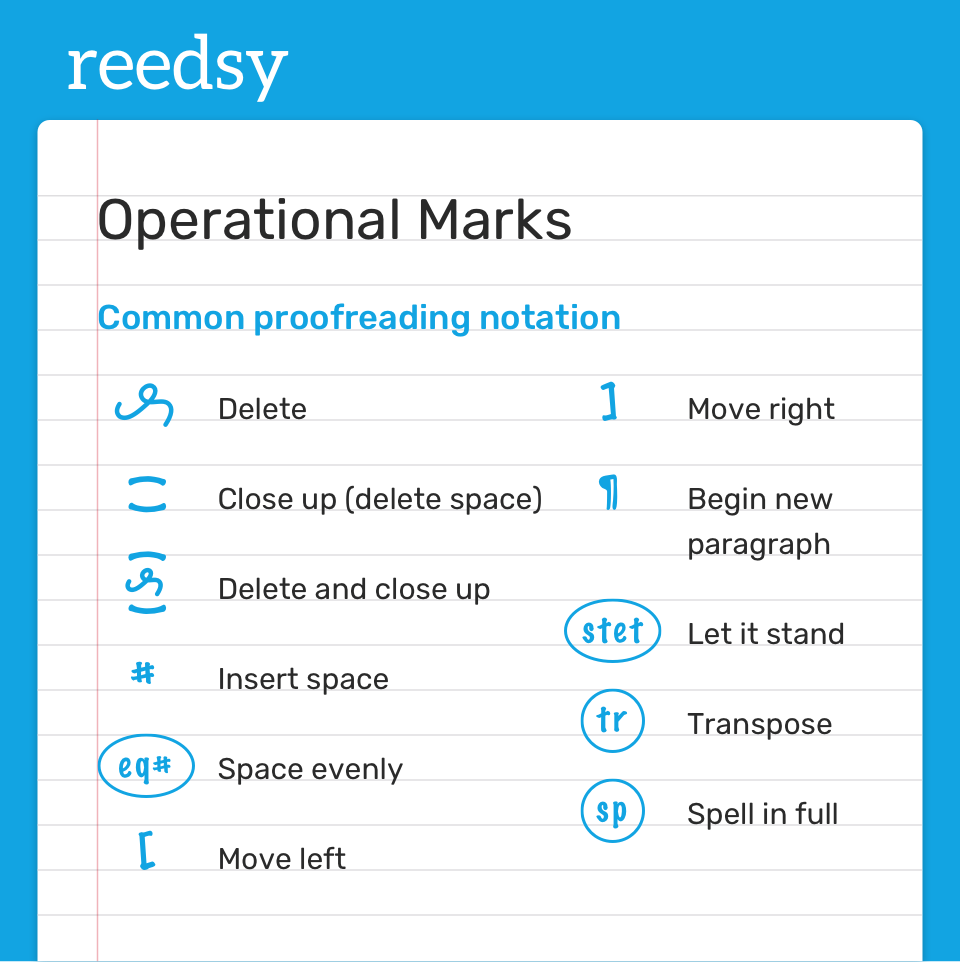
- The “delete” symbol on its own will refer to a word, while “delete and close up” will refer to a letter in a word.
- The ”let it stand” symbol would be used when more than one round of proofreading was done, and it indicates that a correction or alteration should be ignored.
- The “transpose” symbol indicates the order of words needs to be changed (spot the transpose problem).
Next up are the punctuation marks, which — you guessed it — indicate that punctuation needs to be added.
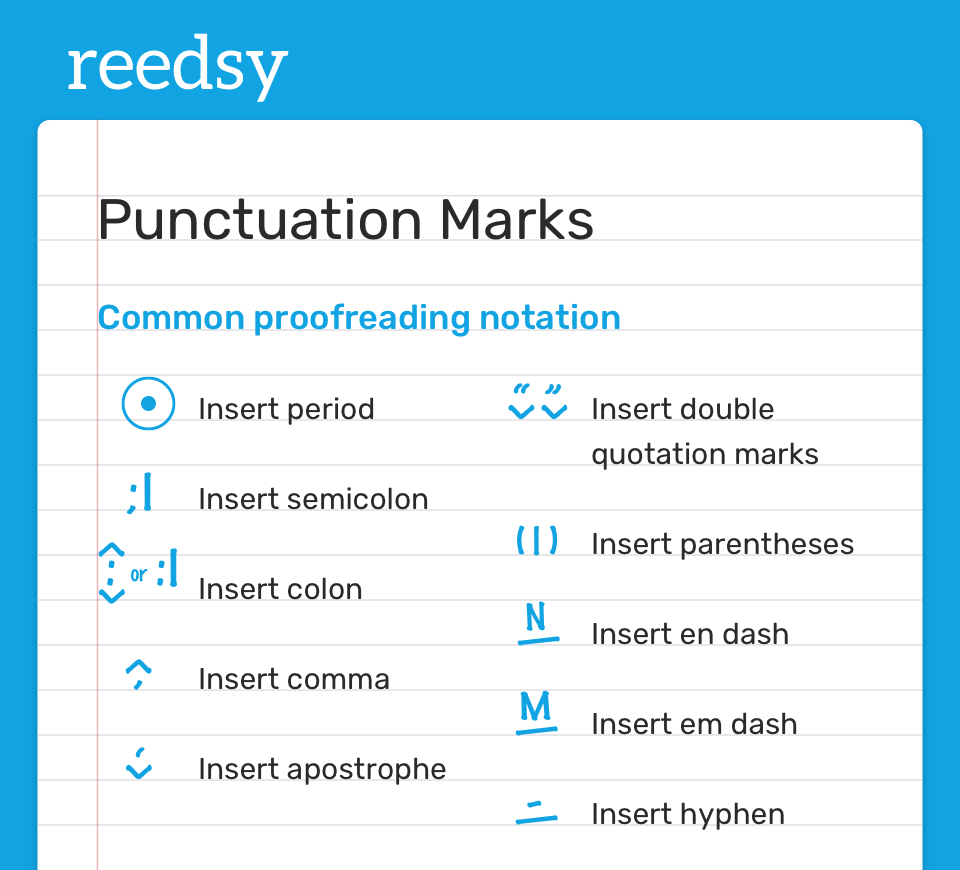
Then there are typography marks, which denote formatting corrections.

Lastly, these are common abbreviations used by proofreaders to indicate issues related to the copy itself.
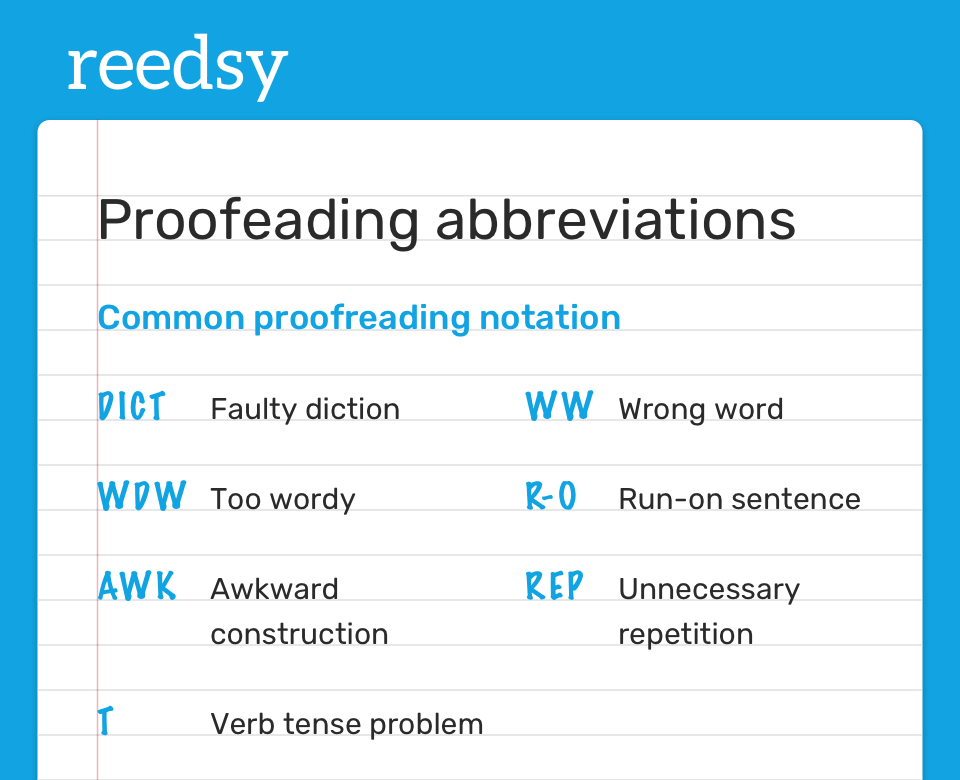
The importance of proofreading
Ensuring that your book is polished and error-free is just as important to the reader experience as the writing quality. Your book can’t effectively communicate if the reader is constantly paused by spelling mistakes, awkward sentence structures, or uneven spacing.
Here's what these proofreading marks look like in use, when a proofreader returns a manuscript, and when their suggestions have been incorporated:
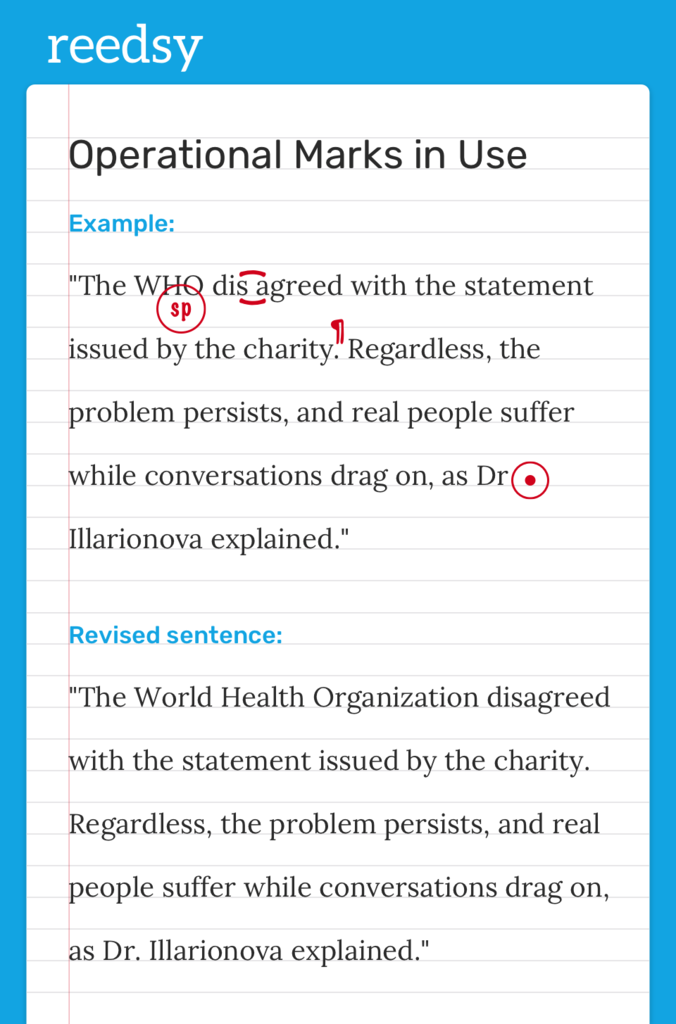
Looking to get your book proofread?
First, we recommend doing as much of the work yourself as possible. Here are a few resources that will help:
- The Reedsy Book Editor will point out spelling and grammatical errors as you go.
- How to Self-Edit Your Manuscript Like a Pro is a free Reedsy Learning course covering the ten most common writing mistakes — both how to find and fix them.
- What to Expect From Beta Readers And Where to Find Them is a post written by a Reedsy author who worked extensively with beta readers to get his book ready for publication.
- What are Sensitivity Readers? And Should Authors Use Them? is all about the controversial topic of sensitivity readers and what they actually do.
Free course: How to self-edit like a pro
Rid your manuscript of the most common writing mistakes with this 10-day online course. Get started now.
Once you’ve done all the proofreading work you can, we encourage you to consider working with a professional. Proofreading is the final stage of the editing process and will ensure your book fully meets its potential for success.
The average costs of working with a professional proofreader on Reedsy are:
- $350 for a 40k-word book
- $520 for a 60k-word book
- $700 for an 80k-word book
Head to our marketplace to request quotes from a variety of professional proofreaders for free.
Have you ever worked with a professional proofreader? Or do you prefer to go the DIY route? Leave any thoughts or questions in the comments below!
Continue reading
Recommended posts from the Reedsy Blog

How to Publish a Book For Free: The 7 Best Sites
If you want to publish your book without spending a single dime, check out this handy list of 7 free self-publishing services.
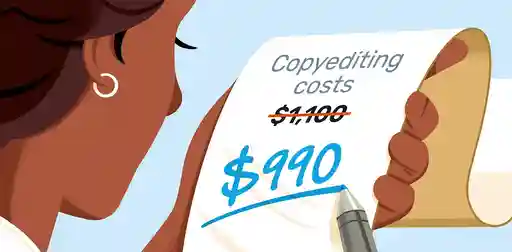
5 Ways to Save on Your Self-Publishing Budget
If you want to self-publish a book without breaking the bank, here are 5 tips to ensure you still get the best result possible.

30 Great Book Dedication Examples to Inspire Your Own
A list of 30 of the best book dedications in the business, that'll have you crying, laughing, and crying laughing.

Expository Writing: The Craft of Sharing Information
Expository writing is a fundamental part of how we learn and make sense of the world. Learn all about it in this post.

Additional Reviews: Query Critique December 2024
Additional critiques from Reedsy's December 2024 query letter session.

How to Make Money by Writing Books: 8 Tips for Success
If you want to be an author who makes a living from books, here are eight tips to help you make money as a writer.
Join a community of over 1 million authors
Reedsy is more than just a blog. Become a member today to discover how we can help you publish a beautiful book.
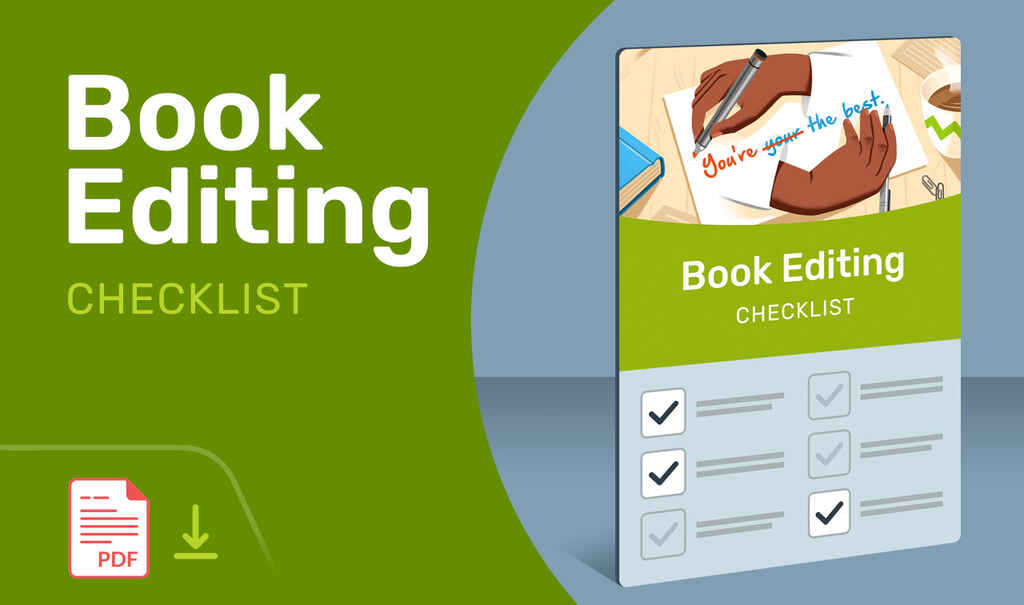
Edit your book like a pro
Our checklist walks you through the professional standards of the editing process.

1 million authors trust the professionals on Reedsy. Come meet them.
Enter your email or get started with a social account:
- More from M-W
- To save this word, you'll need to log in. Log In
Definition of proofread
transitive verb
Examples of proofread in a Sentence
These examples are programmatically compiled from various online sources to illustrate current usage of the word 'proofread.' Any opinions expressed in the examples do not represent those of Merriam-Webster or its editors. Send us feedback about these examples.
Word History
back-formation from proofreader
1845, in the meaning defined above
Articles Related to proofread
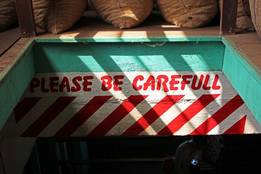
Showing Off Your [Sic] Moves
It's not just for pointing out errors.
Dictionary Entries Near proofread
proof press
proofreader
Cite this Entry
“Proofread.” Merriam-Webster.com Dictionary , Merriam-Webster, https://www.merriam-webster.com/dictionary/proofread. Accessed 8 Apr. 2024.
Kids Definition
Kids definition of proofread, more from merriam-webster on proofread.
Thesaurus: All synonyms and antonyms for proofread
Nglish: Translation of proofread for Spanish Speakers
Subscribe to America's largest dictionary and get thousands more definitions and advanced search—ad free!

Can you solve 4 words at once?
Word of the day.
See Definitions and Examples »
Get Word of the Day daily email!
Popular in Grammar & Usage
The tangled history of 'it's' and 'its', more commonly misspelled words, why does english have so many silent letters, your vs. you're: how to use them correctly, every letter is silent, sometimes: a-z list of examples, popular in wordplay, the words of the week - apr. 5, 12 bird names that sound like compliments, 10 scrabble words without any vowels, 12 more bird names that sound like insults (and sometimes are), 8 uncommon words related to love, games & quizzes.

- Cambridge Dictionary +Plus
Meaning of proofread in English
Your browser doesn't support HTML5 audio
- anthologist
- blue pencil
- bowdlerization
- bowdlerized
- non-editorial
- post-editing
- proofreading
Related word
Proofread | intermediate english, proofread | business english, examples of proofread, translations of proofread.
Get a quick, free translation!

Word of the Day
to add harmonies to a tune

Shoots, blooms and blossom: talking about plants

Learn more with +Plus
- Recent and Recommended {{#preferredDictionaries}} {{name}} {{/preferredDictionaries}}
- Definitions Clear explanations of natural written and spoken English English Learner’s Dictionary Essential British English Essential American English
- Grammar and thesaurus Usage explanations of natural written and spoken English Grammar Thesaurus
- Pronunciation British and American pronunciations with audio English Pronunciation
- English–Chinese (Simplified) Chinese (Simplified)–English
- English–Chinese (Traditional) Chinese (Traditional)–English
- English–Dutch Dutch–English
- English–French French–English
- English–German German–English
- English–Indonesian Indonesian–English
- English–Italian Italian–English
- English–Japanese Japanese–English
- English–Norwegian Norwegian–English
- English–Polish Polish–English
- English–Portuguese Portuguese–English
- English–Spanish Spanish–English
- English–Swedish Swedish–English
- Dictionary +Plus Word Lists
- English Verb
- Intermediate Verb
- Business Verb
- Translations
- All translations
Add proofread to one of your lists below, or create a new one.
{{message}}
Something went wrong.
There was a problem sending your report.
Your path to academic success
Improve your paper with our award-winning Proofreading Services , Plagiarism Checker , Citation Generator , AI Detector & Knowledge Base .
Proofreading & Editing
Get expert help from Scribbr’s academic editors, who will proofread and edit your essay, paper, or dissertation to perfection.
Plagiarism Checker
Detect and resolve unintentional plagiarism with the Scribbr Plagiarism Checker, so you can submit your paper with confidence.
Citation Generator
Generate accurate citations with Scribbr’s free citation generator and save hours of repetitive work.

Happy to help you
You’re not alone. Together with our team and highly qualified editors , we help you answer all your questions about academic writing.
Open 24/7 – 365 days a year. Always available to help you.
Very satisfied students
This is our reason for working. We want to make all students happy, every day.
Ease of use and excellent citation…
Ease of use and excellent citation support
It works exceptionally well
It works exceptionally well, some references that are not open to the public, you sometimes have to manually cite. But as research should be public as students don't have 40€ to pay for a research paper, I find it acceptable as I would not want to us those papers anyway for everything else it works great.
Simplistic and Efficient
Very helpful in creating citations while also creating the in paragraph citations, saves so much time very simple and easy to use. Even when it cannot cite it aids in helping me create my own citations.
Awesome experience!
Scribbr has helped me in my college…
Scribbr has helped me in my college citations. It is an excellent tool to do a better job.
Huge time saver!
I have used Scribbr for the duration of my degree program. It is a huge time saver and allows me to focus on content rather than worrying about if I put the date in the correct location in my citation.
Very user friendly and gives accurate…
Very user friendly and gives accurate information.
This is a fantastic site to cite your…
This is a fantastic site to cite your references in the correct format quickly! I know I was able to cite all of my references correctly in my last paper because of this program.
It always helps get the job done.
Easy and efficient to use.
This tool has helped me write many…
This tool has helped me write many papers in my doctoral program. The citation tool is the best, and the fact that it keeps me on track from making plagiarism mistakes is very helpful.
The majority of the time it's correct, but sometimes manual entry is needed.
Great time saver
Great time saver, easy to use and accurate in most situations.
Having the resource of rephrasing…
Having the resource of rephrasing sections of text for my graduate papers has been helpful when my thoughts were just not coming together.
Great for Citation generator
I can only speak for the citation generator as that is the only product I've used by Scribbr all these years. By far a must-use for any college course. Scribbr is a free citation generator that provides so much value for users. No BS here. It's helped me properly cite papers for many years. Worth the check.
It is very accurate and has helped me…
It is very accurate and has helped me with citations tremendously.
I love Scribbr.
I love Scribbr.. it does glitch at times and give incorrect citations (i've contact support a few times) but overall, it works very well. The paraphraser if also very useful!!
Everything was so simple
Instant citations
It's really helpful to be able to generate citations in whatever style you need, directly from your browser. I use it every day.
I LOVE Scribbr
I LOVE Scribbr. It's the best citation tool I have used.
Everything you need to write an A-grade paper
Free resources used by 5,000,000 students every month.
Bite-sized videos that guide you through the writing process. Get the popcorn, sit back, and learn!

Lecture slides
Ready-made slides for teachers and professors that want to kickstart their lectures.
- Academic writing
- Citing sources
- Methodology
- Research process
- Dissertation structure
- Language rules
Accessible how-to guides full of examples that help you write a flawless essay, proposal, or dissertation.

Chrome extension
Cite any page or article with a single click right from your browser.
Time-saving templates that you can download and edit in Word or Google Docs.
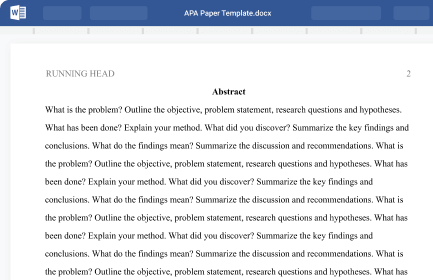
Help you achieve your academic goals
Whether we’re proofreading and editing , checking for plagiarism or AI content , generating citations, or writing useful Knowledge Base articles , our aim is to support students on their journey to become better academic writers.
We believe that every student should have the right tools for academic success. Free tools like a paraphrasing tool , grammar checker, summarizer and an AI Proofreader . We pave the way to your academic degree.
Ask our team
Want to contact us directly? No problem. We are always here for you.
- Email [email protected]
- Start live chat
- Call +1 (510) 822-8066
- WhatsApp +31 20 261 6040

Frequently asked questions
Our team helps students graduate by offering:
- A world-class citation generator
- Plagiarism Checker software powered by Turnitin
- Innovative Citation Checker software
- Professional proofreading services
- Over 300 helpful articles about academic writing, citing sources, plagiarism, and more
Scribbr specializes in editing study-related documents . We proofread:
- PhD dissertations
- Research proposals
- Personal statements
- Admission essays
- Motivation letters
- Reflection papers
- Journal articles
- Capstone projects
Scribbr’s Plagiarism Checker is powered by elements of Turnitin’s Similarity Checker , namely the plagiarism detection software and the Internet Archive and Premium Scholarly Publications content databases .
The add-on AI detector is powered by Scribbr’s proprietary software.
The Scribbr Citation Generator is developed using the open-source Citation Style Language (CSL) project and Frank Bennett’s citeproc-js . It’s the same technology used by dozens of other popular citation tools, including Mendeley and Zotero.
You can find all the citation styles and locales used in the Scribbr Citation Generator in our publicly accessible repository on Github .

IMAGES
VIDEO
COMMENTS
Step 1: Content editing. Revising an early draft of a text, often making significant changes to the content and moving, adding or deleting entire sections (also known as developmental or substantive editing). Step 2: Line editing. Revising the use of language to communicate your story, ideas, or arguments as effectively as possible.
Proofreading is the process of carefully reviewing written work to find and correct errors in grammar, punctuation, spelling, and formatting. It is the final step in the writing process; it ensures clean, clear, and professional writing before submission or publication. Keep in mind that proofreading differs from other writing steps, such as ...
3) Enhancing writing quality: Proofreading is an integral part of the writing process that contributes to improving the overall quality of the written work. By eliminating errors, Proofreading enhances the clarity, readability, and coherence of the content. It ensures that the message is effectively conveyed to the intended audience.
In publishing, proofreading comes into play at the very end of the editorial process, after a manuscript has been corrected by a copy or line editor. The proofreader's job is to comb through the document and look for any mistakes that may have slipped through the cracks. Regardless of how meticulous the writer and editor have been, there will ...
Proofreading is an iterative process of comparing galley proofs against the original manuscripts or graphic artworks to identify transcription errors in the typesetting process. In the past, proofreaders would place corrections or proofreading marks along the margins. In modern publishing, material is generally provided in electronic form, traditional typesetting is no longer used and thus (in ...
The word proofreading has taken on a definition separate from the role it plays in the publication of manuscripts. What most people are referring to when they use the word proofreading is the process of checking a document for any kind of grammatical, typographical, or formatting errors. Proofreading should always be the last step taken before ...
Definition. Proofreading is the act of reviewing, identifying, and correcting errors in your research paper before it is handed in to be graded by your professor. ... S hould you need help proofreading your paper, take advantage of the assistance offered by consultants at the USC Writing Center located on the second floor of Taper Hall, room ...
A proofreader is responsible for double-checking documents for errors and typos, including: Typos. Double words ("the the," "and and," etc.) Grammar. Punctuation. Spelling. Formatting issues. Ensure document adheres to chosen style guide. Traditionally, proofreading would have been done when the book had been formatted and laid out, so ...
The proofreading process becomes more efficient as you develop and practice a systematic strategy. You'll learn to identify the specific areas of your own writing that need careful attention, and knowing that you have a sound method for finding errors will help you to focus more on developing your ideas while you are drafting the paper.
The average cost of proofreading a research paper is $39-$69 per 1,000 words. However, the rates for rush jobs, niche topics, and complex formatting styles are significantly higher than those for simpler topics with a slower turnaround time. The criteria for charging clients also vary from one professional to another.
The meaning of PROOFREADER is a person who proofreads. a person who proofreads… See the full definition. Games & Quizzes; Games & Quizzes; Word of the Day; Grammar ... Share the Definition of proofreader on Twitter Twitter. More from Merriam-Webster on proofreader. Nglish: Translation of proofreader for Spanish Speakers.
Make sure that you leave plenty of time after you have finished your paper to walk away for a day or two, a week, or even 20 minutes. This will allow you to approach proofreading with fresh eyes. Print out a hard copy. Reading from a computer screen is not the most effective way to proofread. Having a hardcopy of your paper and a pen will help you.
The four stages of editing and proofreading. Type of editing. What it involves. Step 1: Content editing. Revising an early draft of a text, often making significant changes to the content and moving, adding or deleting entire sections (also known as developmental or substantive editing). Step 2: Line editing.
Proofreading is the last step of the editing process. It follows the processes of developmental, line, and copy editing as well as the process of typesetting. Your manuscript is ready to be proofread if: The developmental editor has improved the quality of your manuscript by making large-scale changes in its content.
Proofreading is the final stage of the editing process and will ensure your book fully meets its potential for success. The average costs of working with a professional proofreader on Reedsy are: $350 for a 40k-word book. $520 for a 60k-word book. $700 for an 80k-word book. Head to our marketplace to request quotes from a variety of ...
PROOFREADING meaning: 1. the process of finding and correcting mistakes in text before it is printed or put online: 2…. Learn more.
PROOFREADER definition: 1. a person whose job is to check text before it is printed or put online 2. a person whose job is…. Learn more.
The meaning of PROOFREAD is to read and mark corrections in (something, such as a proof). ... He proofread the essay carefully. ... Share the Definition of proofread on Twitter Twitter. Kids Definition. proofread. verb. proof· read ˈprü-ˌfrēd . proofread-ˌfred ; proofreading
PROOFREAD meaning: 1. to find and correct mistakes in text before it is printed or put online 2. to find and correct…. Learn more.
Improve your paper with our award-winning Proofreading Services, Plagiarism Checker, Citation Generator, AI Detector & Knowledge Base. Proofreading & Editing Get expert help from Scribbr's academic editors, who will proofread and edit your essay, paper, or dissertation to perfection.